Let’s be honest. Japan is delicious no matter where you go. From konbini snacks to kaiten-zushi to kaiseki meals, I don’t think I’ve ever had a poor dining experience anywhere in Japan.
We first visited northern Kyushu in 2017 and got to enjoy regional specialties like champon, basashi, and everyone’s favorite Hakata ramen. Everything we had made an impression and got us excited to come back and explore more of the island and its myriad delicacies.
We had booked that return trip for early 2020 when I received an unexpected email from our friends at Cebu Pacific Airlines. They invited me to go on this 4-day FAM trip to explore Fukuoka, Oita, and Nagasaki. That meant four days of Japanese castles, Shinto shrines, and of course, the most delicious regional food. I was packed faster than you can say “oishi”.
If you’re planning a trip to this part of the country, then here are ten food experiences to look for in northern Kyushu.
Save This on Pinterest!
No time to read this now? Click on the red save button and pin it for later!
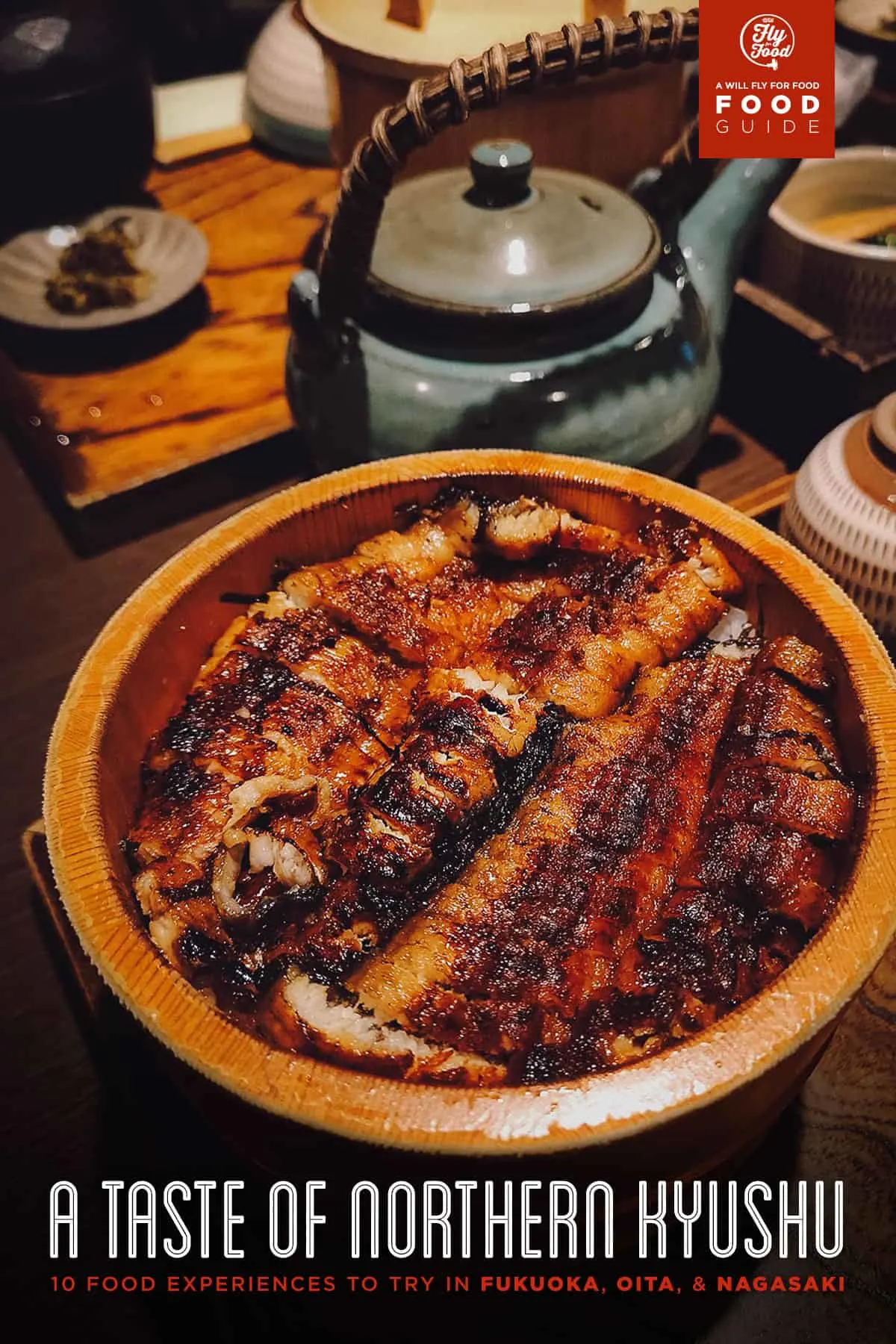
WHERE IS KYUSHU?
Kyushu is the third largest of Japan’s five main islands. It’s located in the southern end of the country and is home to 8 of Japan’s 47 prefectures. In the north are Fukuoka, Nagasaki, Oita, Kumamoto, and Saga prefectures, while in the south are Kagoshima, Miyazaki, and Okinawa.
If Kyushu is your port of entry into Japan, then you’ll probably be flying into Fukuoka International Airport. It’s the principal airport in Kyushu and the fourth busiest passenger airport in the country.
At this time, Fukuoka is one of four cities in Japan with direct Cebu Pacific flights from Manila. Osaka, Nagoya, and Narita are the other three. We flew in and out of Fukuoka on our Japan trip from two years ago, and I’ll be flying back to Manila from Fukuoka as well in February of 2020.
FUKUOKA
The name “Fukuoka” refers to both the prefecture and its capital city on the northern shore of Kyushu. The region is known for many culinary specialties, some of the most beloved being hakata or tonkotsu ramen, mentaiko, amao strawberries, and motsunabe. Fukuoka is also home to the most yatai food stalls among any city in Japan.
1. Hakata (Tonkotsu) Ramen
Hakata ramen is arguably the most famous of Fukuoka’s regional dishes. Also known as tonkotsu ramen, it’s known for its milky broth made by slowly boiling pork bones over a high flame until its marrow seeps out. Prep times for the broth vary from place to place but I read that it typically takes anywhere between 8-12 hours, even up to 36 and 60 hours depending on the recipe and desired result.
Once the soup base is ready, wheat noodles, chashu pork, and green onions are added to the bowl. Some restaurants may add more but those are the four basic ingredients. Sweet, creamy, rich, and milky, Hakata ramen is personally my favorite type of ramen and something I’d look for on every return trip to Fukuoka.
I went to two Hakata ramen restaurants on this trip – the original branch of the world-famous Ichiran chain and Shodai Hide-chan, one of several restaurants in an all-ramen food hall known as Ramen Stadium.
Ichiran
Ichiran is a global chain of restaurants that started right here in Fukuoka. Like many specialist restaurants in Japan, they serve just one type of ramen – Hakata ramen. They’ve become a favorite of ramen enthusiasts and introverts alike, lauded for their rich tonkotsu broth and solo dining booths which are meant to amplify and enhance the ramen eating experience.
Before serving your ramen, you’ll need to indicate your preferences on an order slip – spice level, richness, noodle texture, etc. This was my first time at Ichiran so I went with the recommended levels for everything. Knowing the Japanese, they spend entire lifetimes perfecting their craft so I wanted the best possible bowl of Ichiran Hakata ramen.
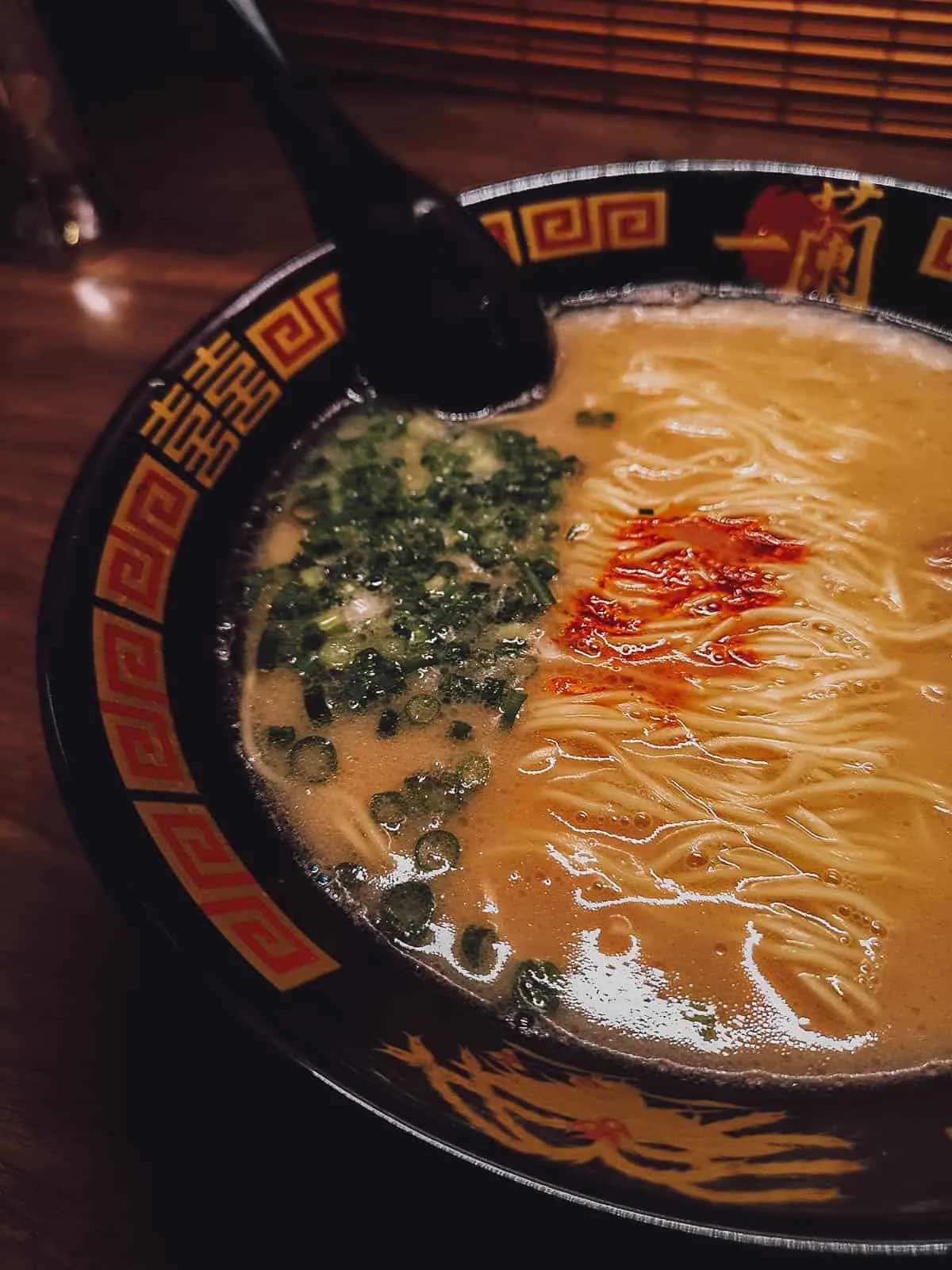
One slurp and you’ll know why Ichiran is so highly regarded wordlwide. Their noodles are perfect – chewy and with just the right amount of bite – but what makes this bowl of Hakata ramen so good is the broth. For me, the soul of any ramen is in its broth. Like bread to a sandwich, it almost doesn’t matter how good the rest of the ingredients are. If the broth is average, then the entire bowl of ramen is average.
Ichiran’s broth isn’t average. It’s delicious – milky, sweet, savory, creamy, and nuanced in flavor. A lot of time went into developing this tonkotsu broth and you can taste it.
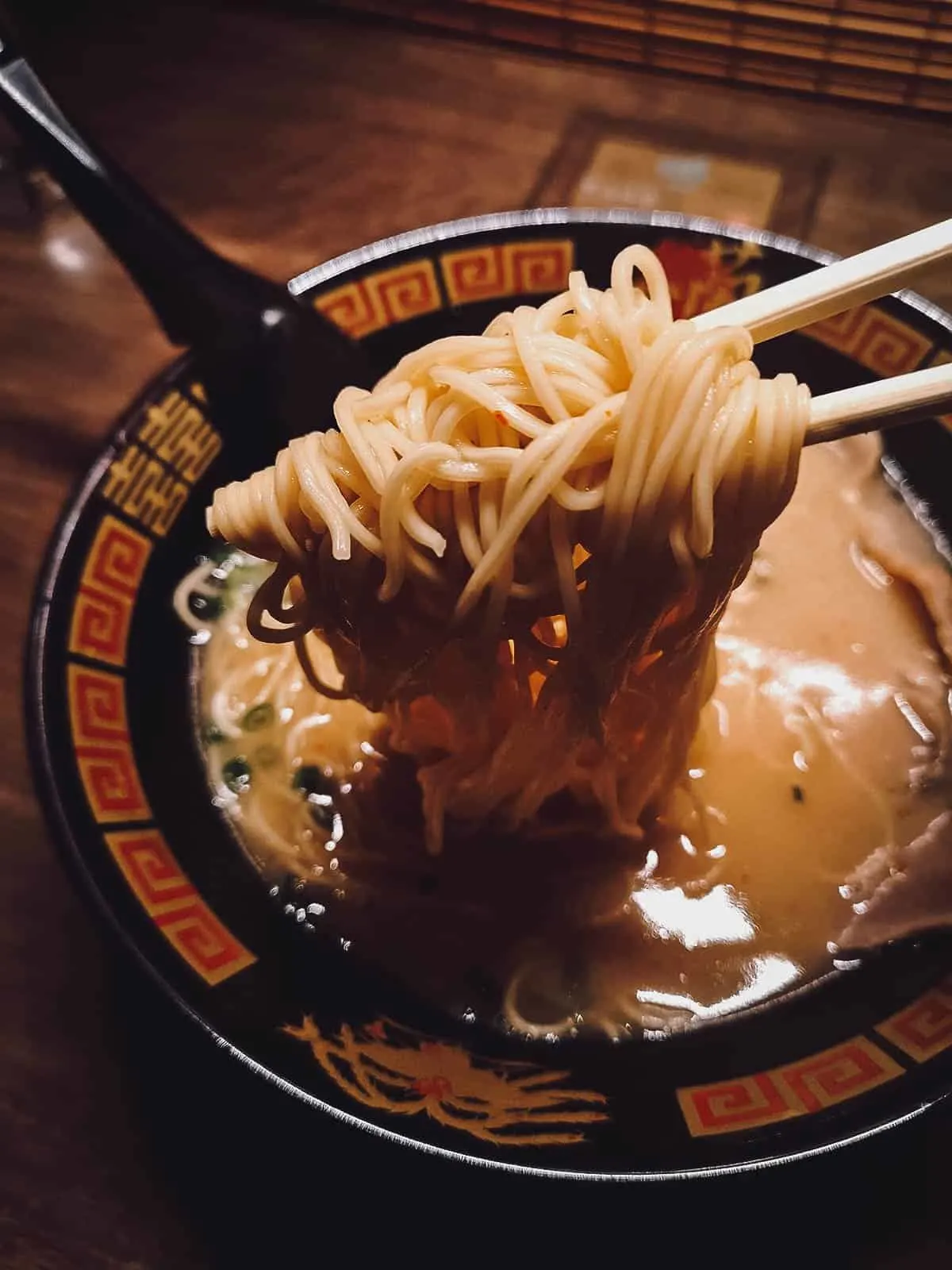
The standard vending machine that you’ll find at (nearly) every ramen shop. Just insert your money and select your food and you’re good to go!
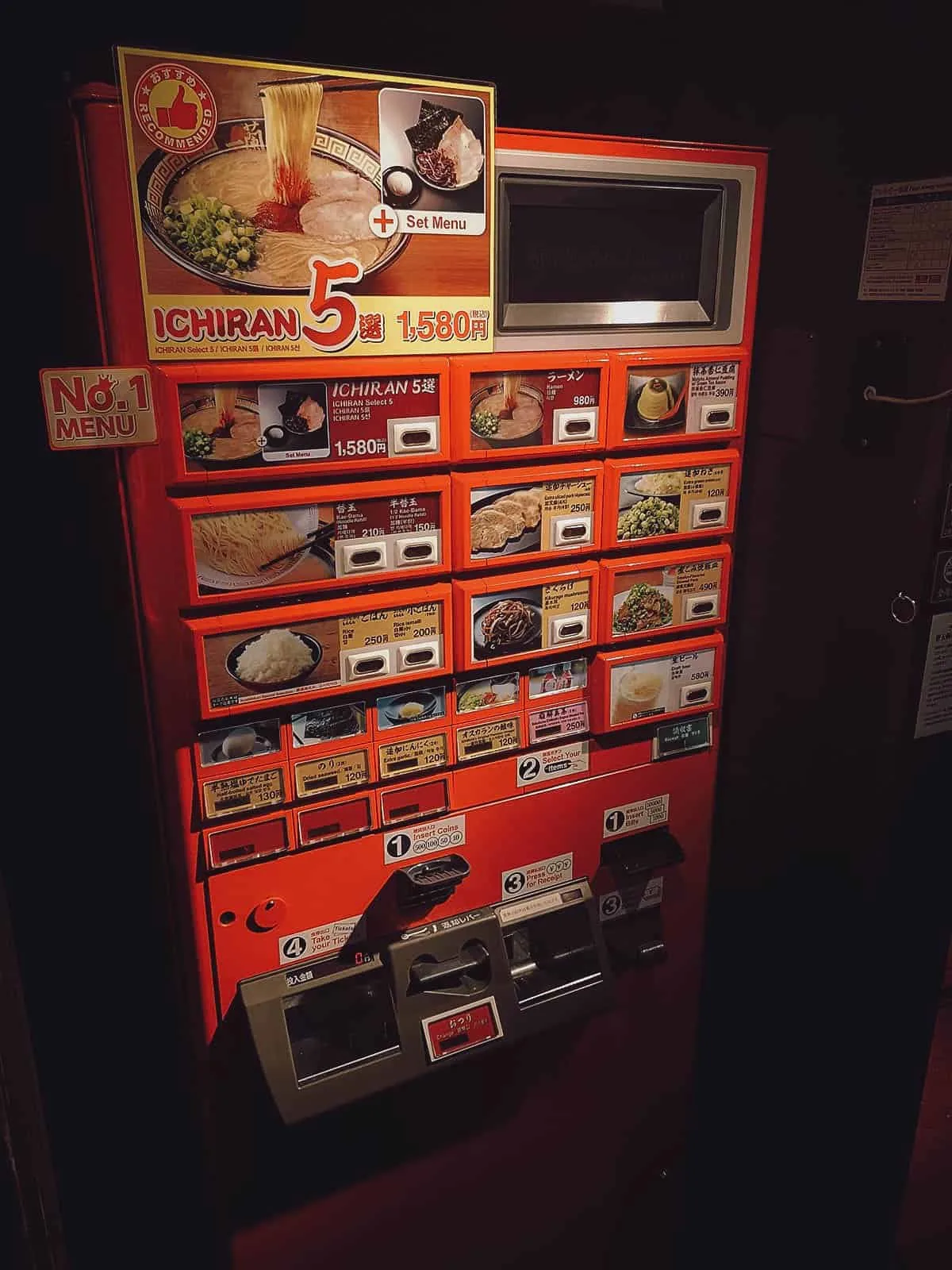
The house that ramen built. This is Ichiran’s original branch. It opened in 1960 as a humble ramen stall called Futaba Ramen. It changed its name to Ichiran (meaning “one orchid”) in 1966 and has since blossomed into a worldwide chain with branches in Hong Kong, Taipei, and New York.
It looks like most of the floors in this building are occupied by corporate offices. Regular tables – you know, the ones for people with social skills? – are on the first floor while the ramen eating cocoons are on the second floor. Up the stairs I go!
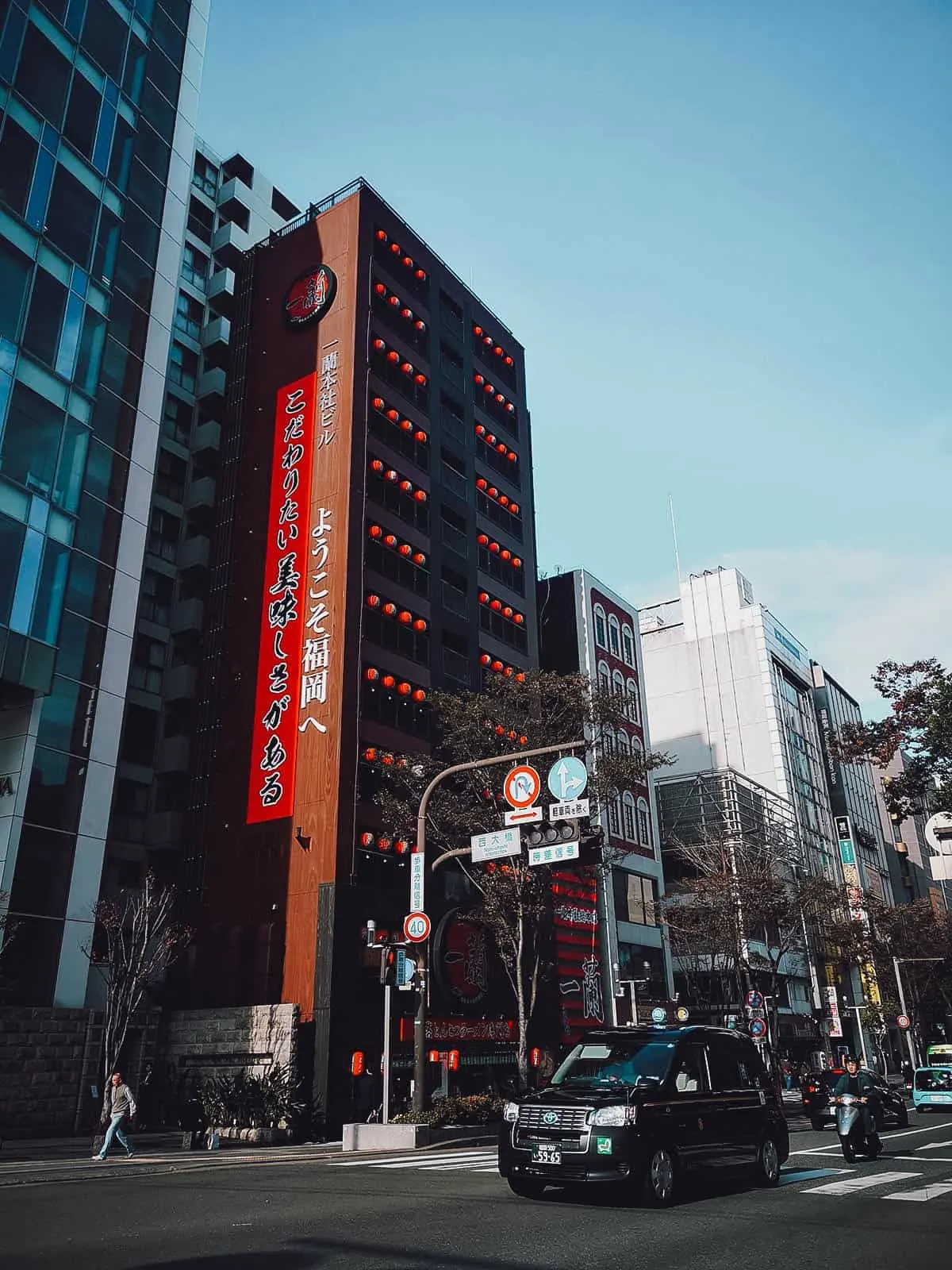
Ichiran
Address: 5 Chome-3-2 Nakasu, Hakata Ward, Fukuoka, 810-0801, Japan
Operating Hours: 24 hrs
What to Order: Hakata ramen
Shodai Hide-chan (初代 秀ちゃん)
This was my first ramen eating experience on this trip. Our group went to Canal City shopping center to have ramen at Ramen Stadium on the 5th floor. It’s a food hall comprised of about 8-10 ramen shops offering every type of ramen available in Japan. From homegrown Hakata ramen to tsukemen to Sapporo’s miso ramen, Ramen Stadium has you covered.
Being in Fukuoka, I wanted nothing but tonkotsu ramen so I googled “best hakata ramen in ramen stadium” and the majority of the results pointed me to Shodai Hide-chan.
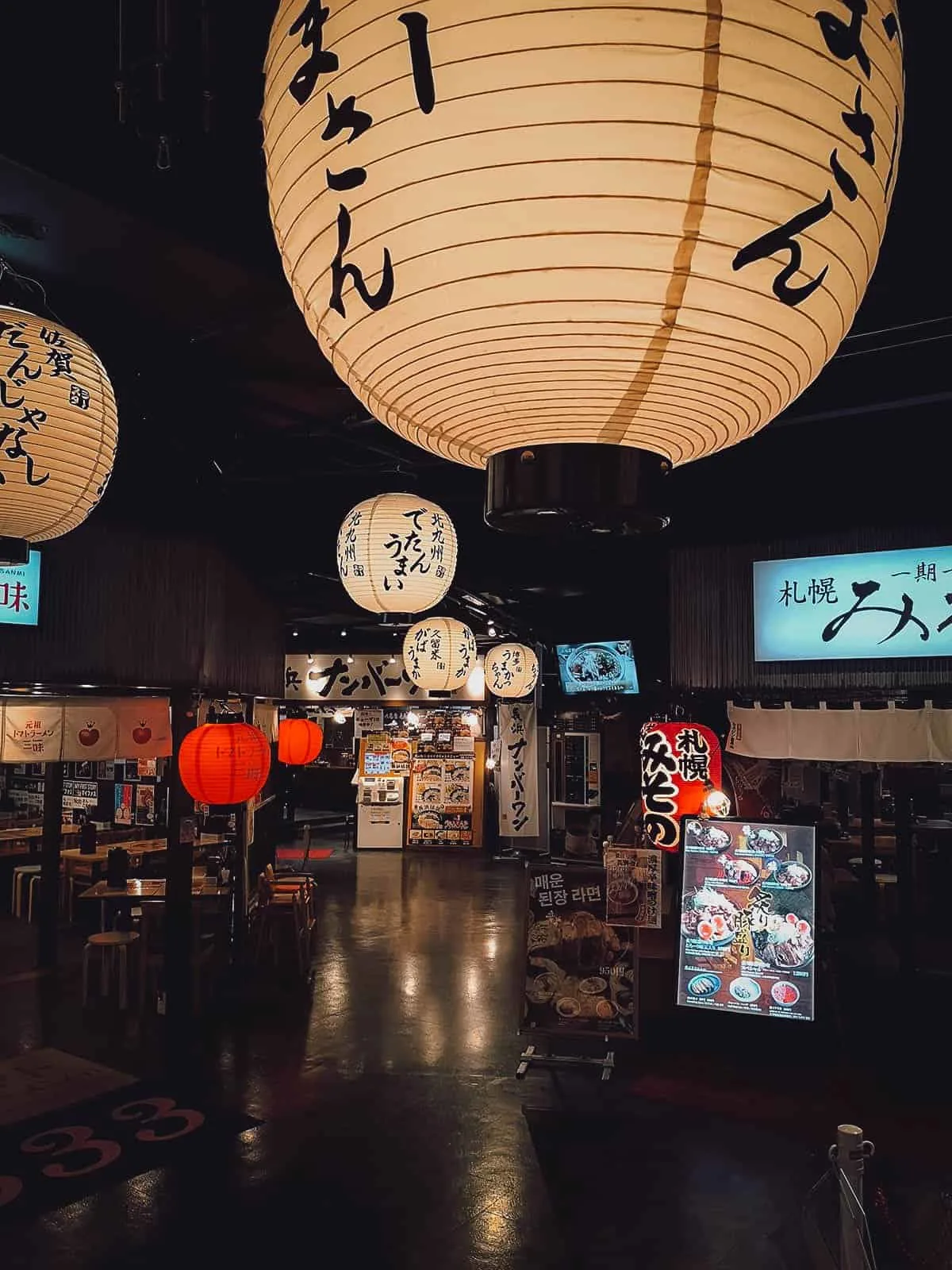
Like I said, you’ll find vending machines like this one in front of most ramen restaurants.
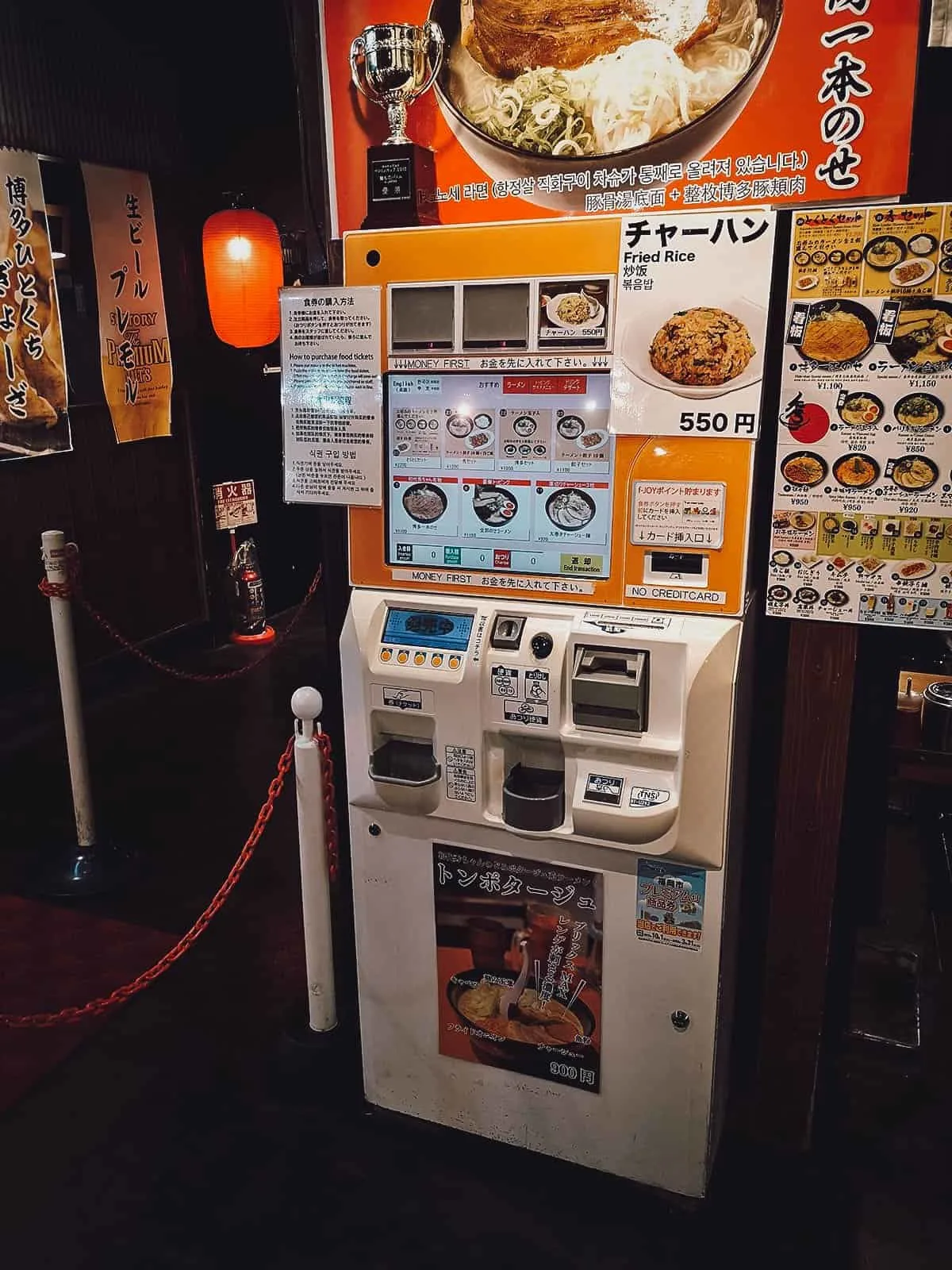
Behold Shodai Hide-chan’s signature bowl of Hakata ramen. As you can see, it looks different from the ramen at Ichiran.
The broth of this ramen isn’t as cloudy and it comes with a host of other ingredients as well. Aside from the standard noodles, green onions, and chashu pork, this heaping bowl also had bean sprouts, pickled greens, pork neck, nori, and a ramen egg.
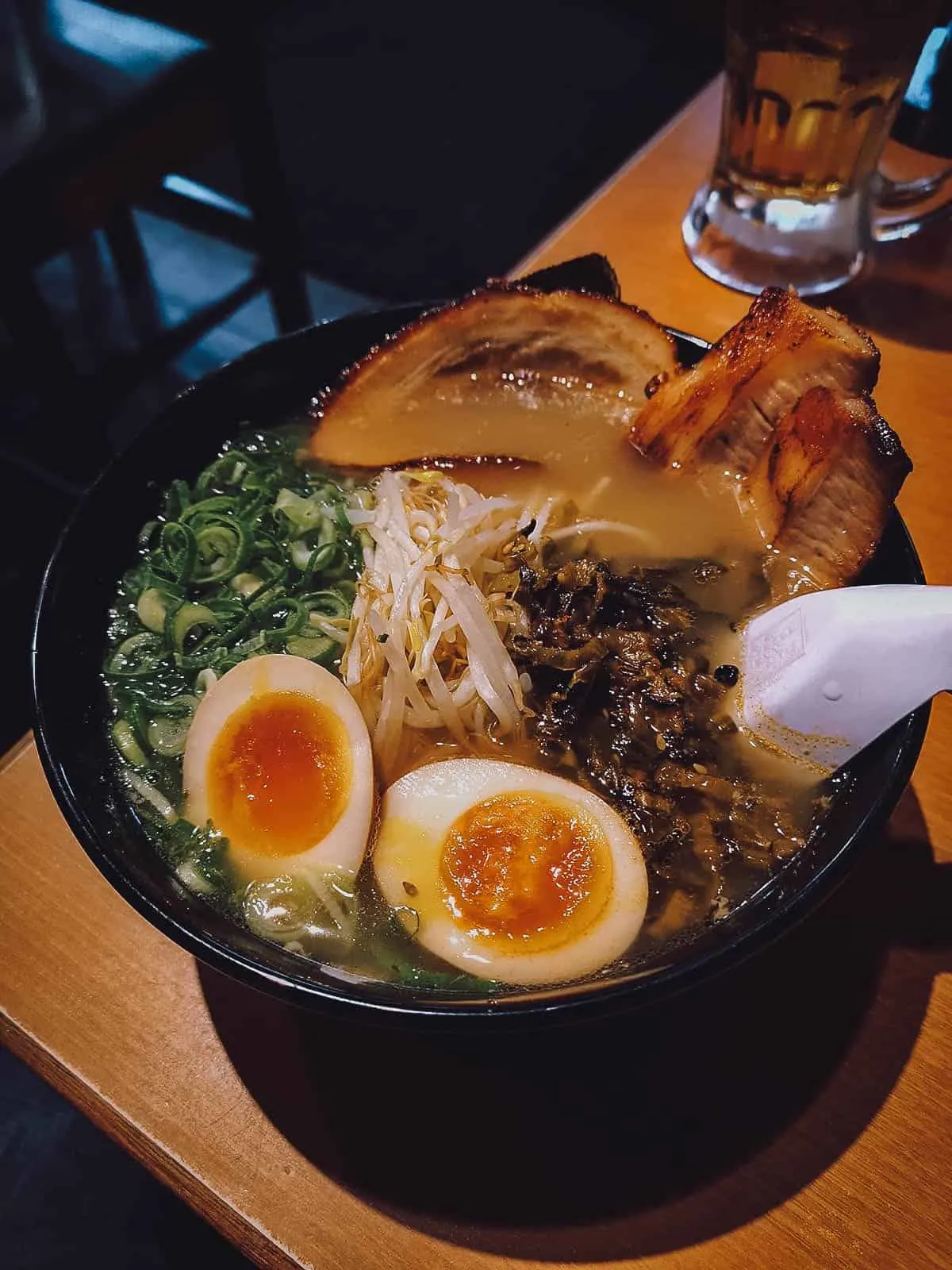
The noodles and other ingredients were great but unfortunately, I didn’t like the ramen broth as much. It tasted noticeably thin and underdeveloped, like it hadn’t been left to boil long enough. If you enjoy milder tasting ramen, then you’ll probably like this one. Personally, I like bold flavors so I preferred the heavier, milkier Hakata ramen at Ichiran.
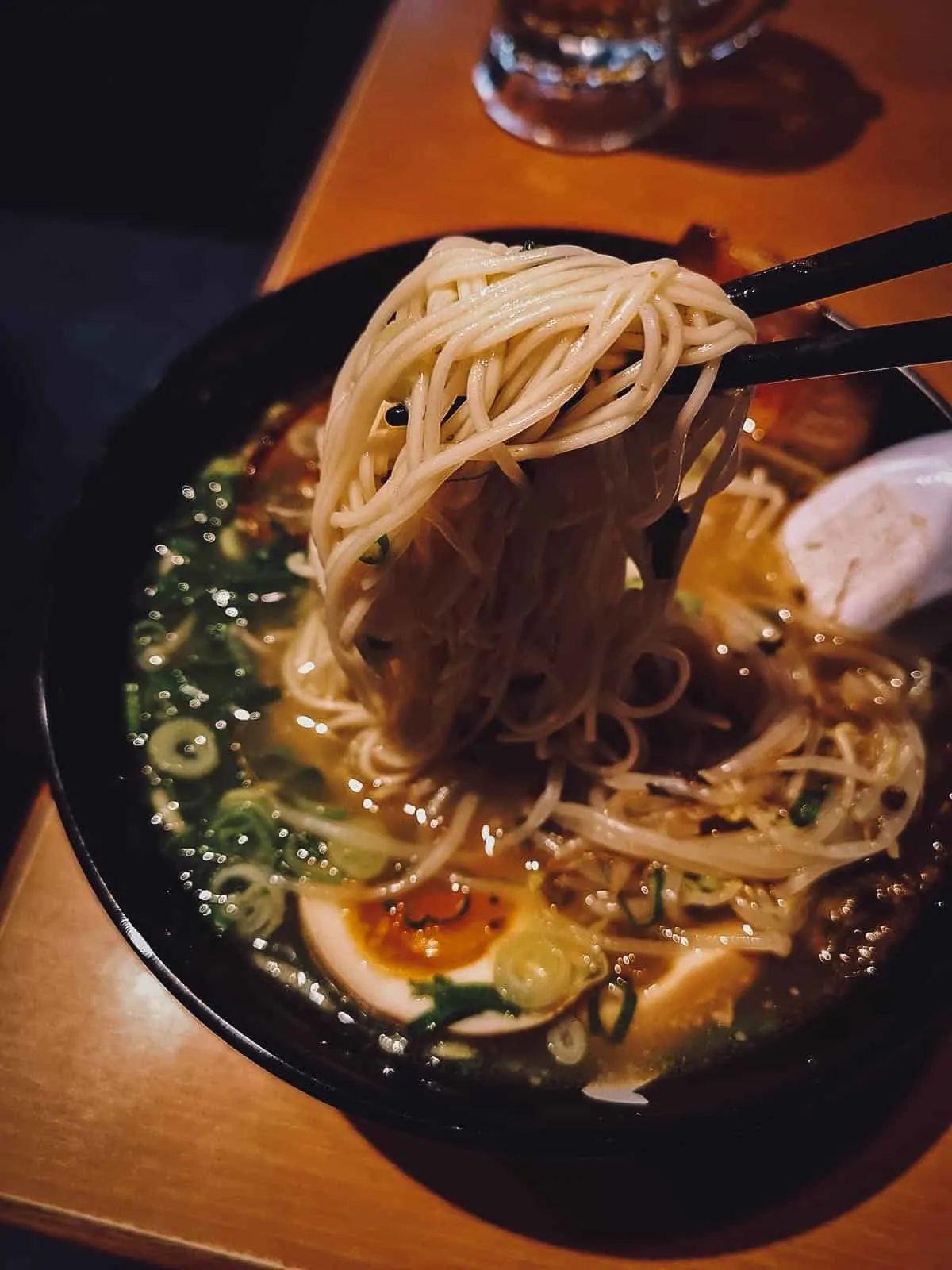
A tender and fatty cut of pork that practically dissolves in your mouth. It’s too bad the broth in this ramen didn’t have as much depth.
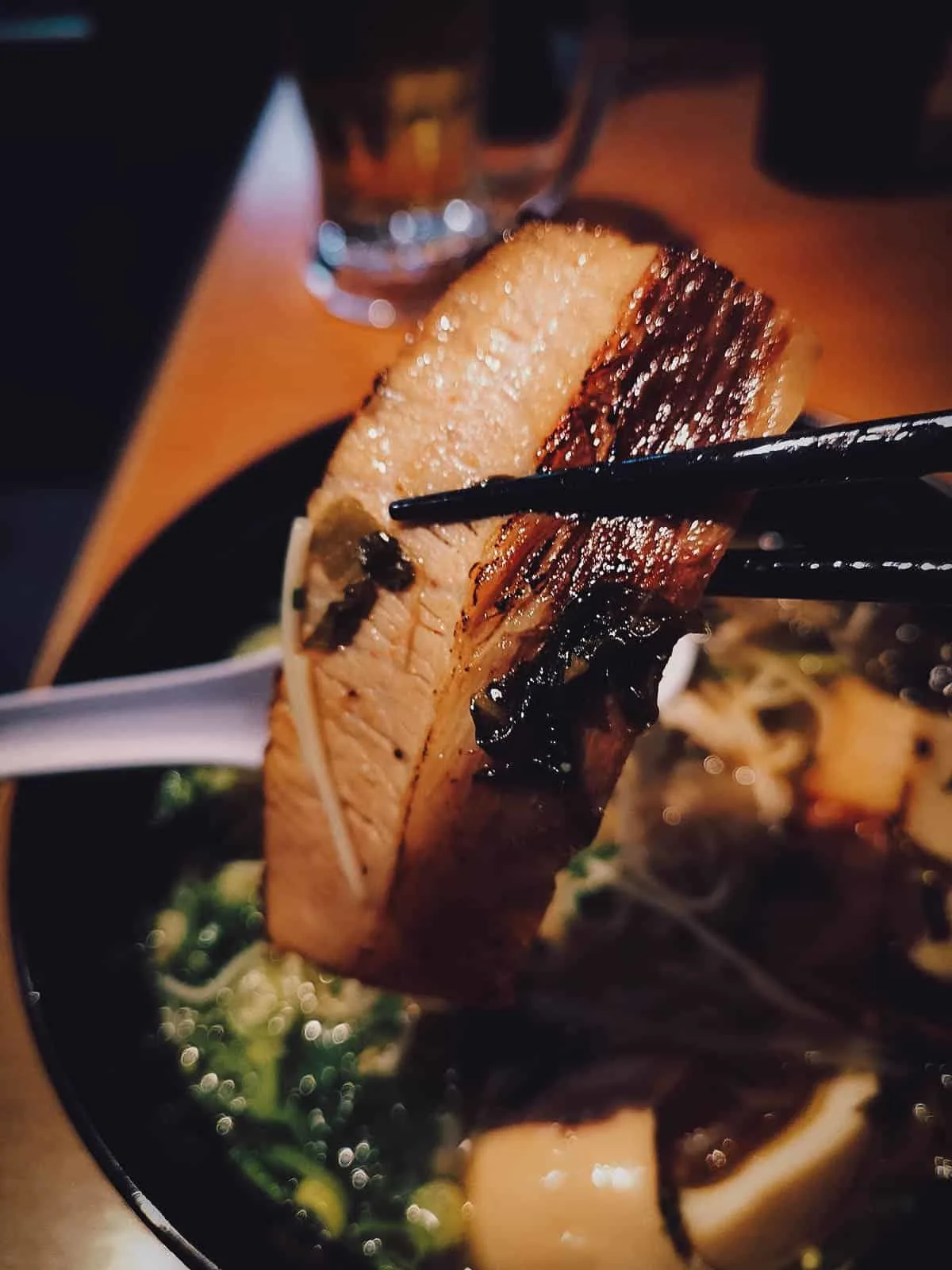
Shodai Hide-chan (初代 秀ちゃん)
Address: Japan, 〒812-0018 Fukuoka, Hakata Ward, Sumiyoshi, 1 Chome−2−22 5F
Operating Hours: 11AM-11PM, daily
What to Order: Hakata ramen
2. Mizutaki
Motsunabe was one of the best things we ate on our last trip to Fukuoka so I was excited to try mizutaki, a similar hotpot dish made with chicken instead of beef or pork offal. I read that it’s typically made with jidori chicken simmered in a broth with chicken meatballs, offal, green onion, cabbage, mushroom, and other seasonal vegetables. The chicken is meant to be eaten with a light and citrusy ponzu sauce.
Hakata Hanamidori
Our group was taken to Hakata Hanamidori to try mizutaki. Like motsunabe, I expected it to be cooked on our table like any hotpot dish but we were each served these pre-cooked personal bowls, probably because we came in such a large group.
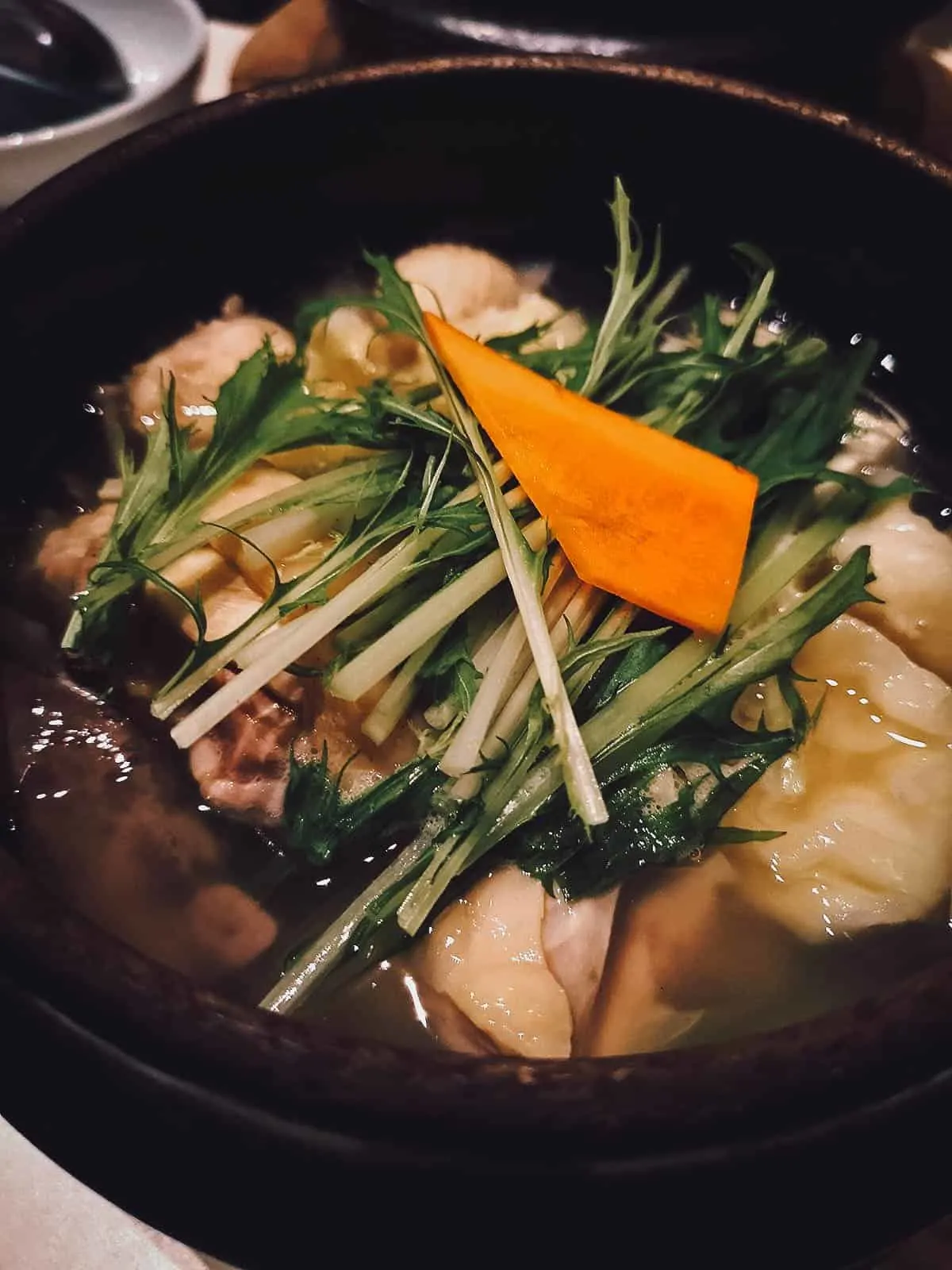
Here’s a piece of what I assume to be jidori chicken. Being a Fukuoka hotpot dish with similar ingredients, I expected mizutaki to taste like motsunabe but it’s considerably milder and more delicate in flavor. It’s almost bland on its own which is why you need to dip it in the ponzu sauce.
As described, I enjoy bold flavors so I much preferred motsunabe over mizutaki.
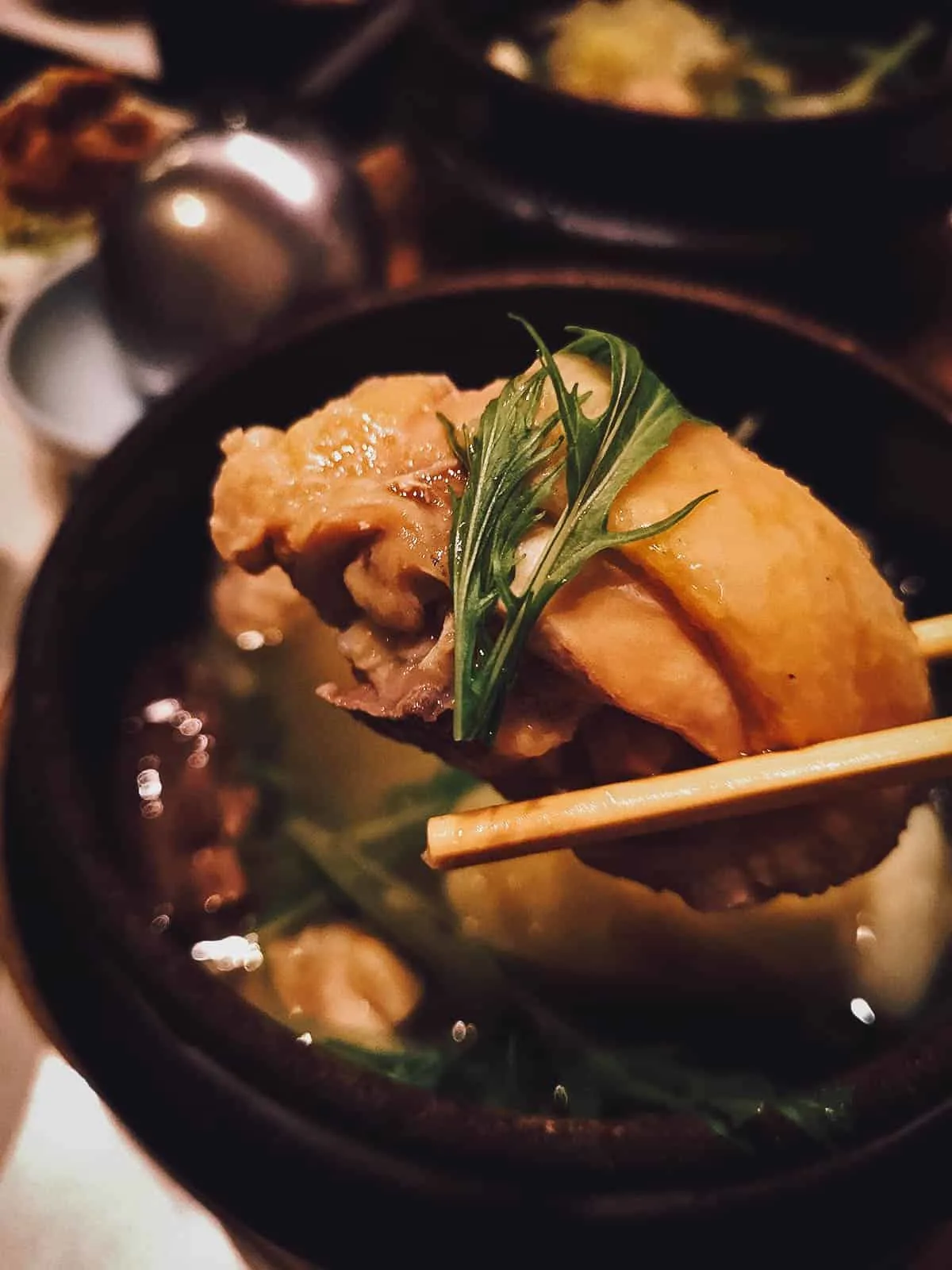
Everyone’s bowl of mizutaki came with a succulent piece of chicken liver.
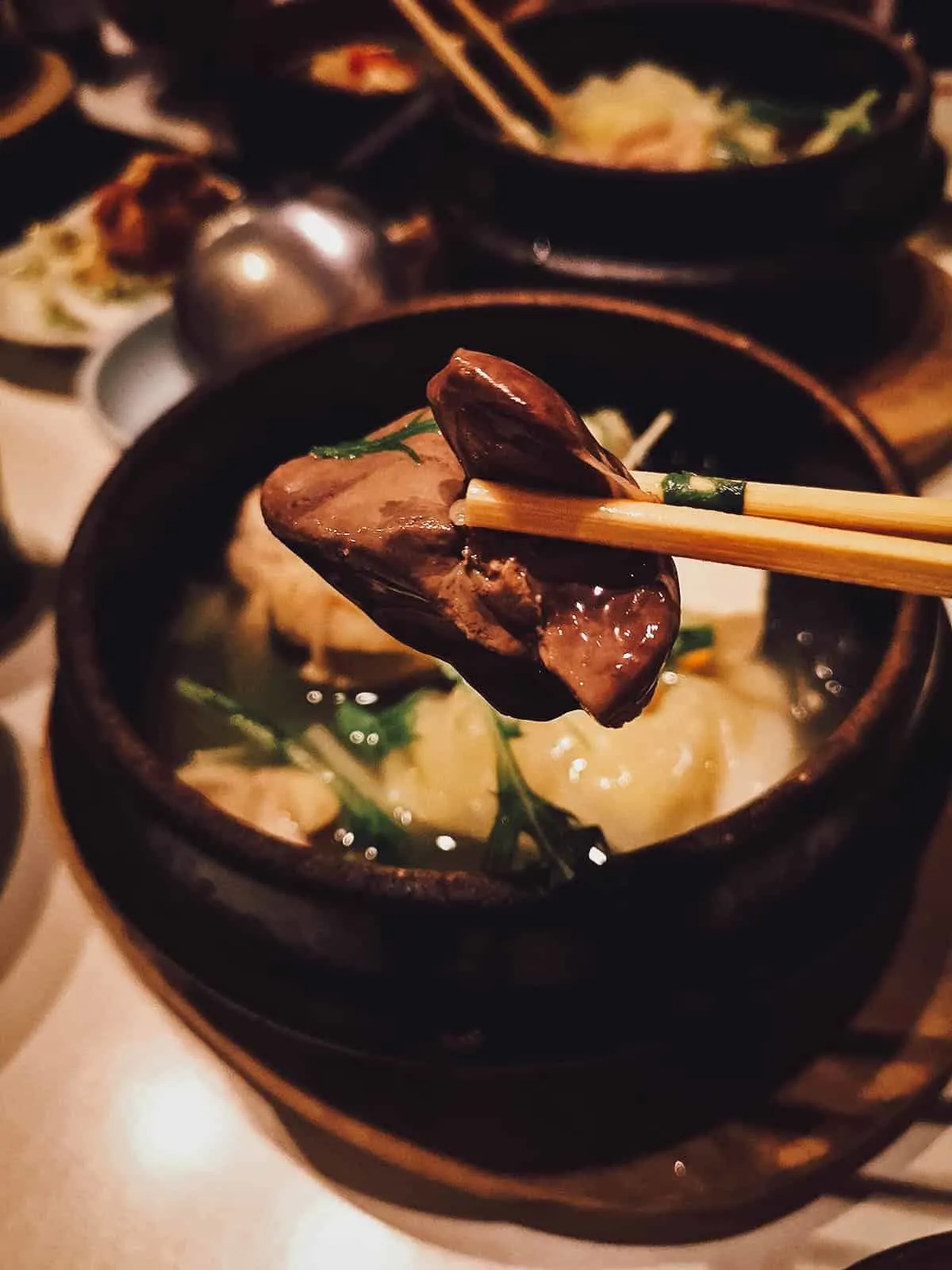
You’ll also find one or two chicken meatballs. I preferred the liver and meatballs to the chicken pieces because they were more flavorful.
Unlike motsunabe which is typically eaten only in winter, mizutaki is a year-round dish.
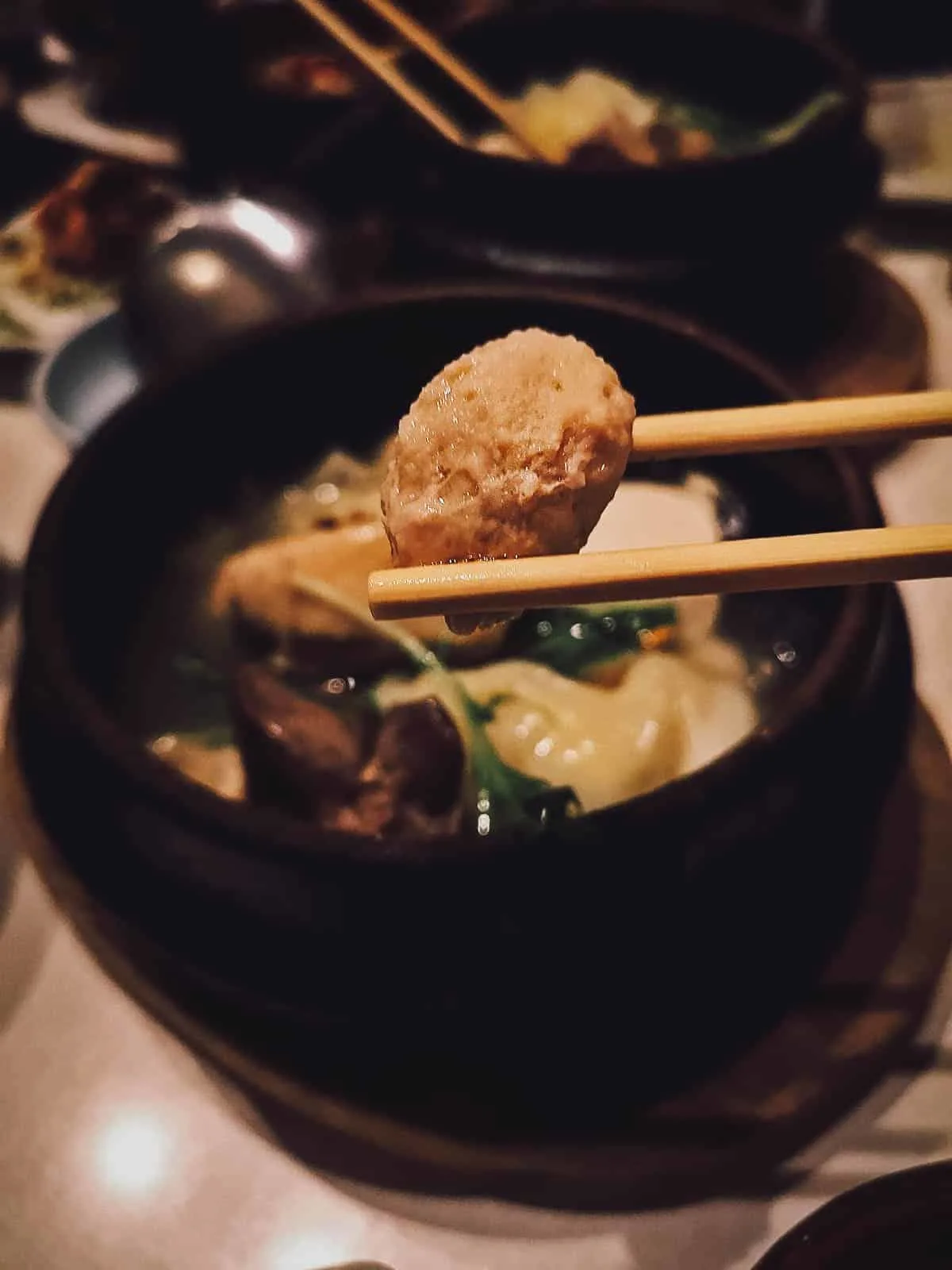
We were each given the Hana full-course set which came with a personal bowl of mizutaki and a trio of appetizers (mentaiko, oysters, and tofu), pickled greens, seaweed, rice, a cup of chicken broth, and the most delicious nugget of chicken karaage.
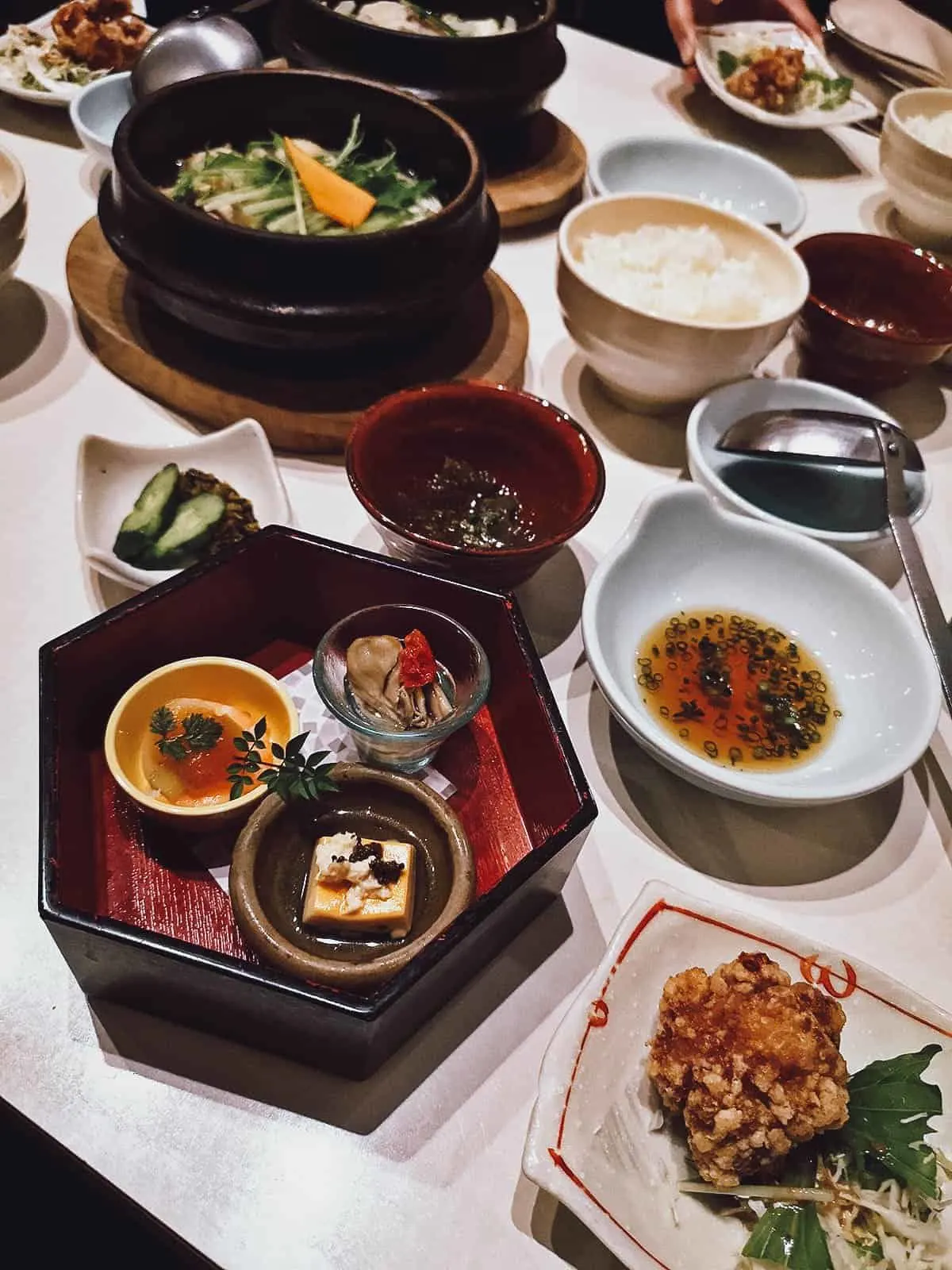
Hakata Hanamidori is located near the Tenjin shopping area in downtown Fukuoka. They’re a TripAdvisor Certificate of Excellence awardee with a solid 4-star rating so don’t be put off by my lukewarm response to mizutaki. This is a good place to try it.
Taste is subjective so it’s all a matter of personal preference. I prefer motsunabe but many people in our group enjoyed the mizutaki at Hakata Hanamidori.
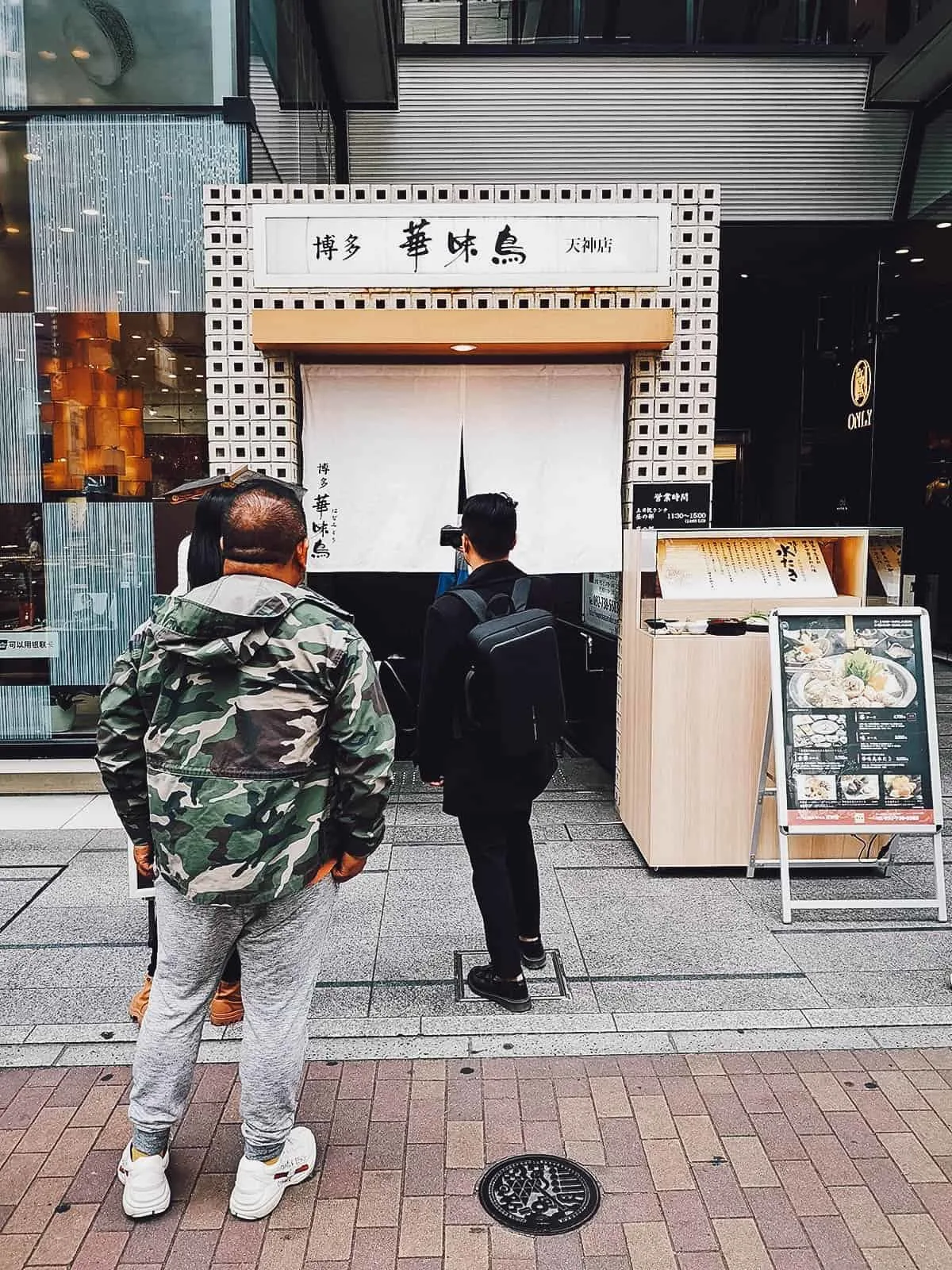
Hakata Hanamidori
Address: 3 Chome-23-17 Hakata Ekimae, Hakata Ward, Fukuoka, 812-0011, Japan
Operating Hours: 11:30AM-3PM, 5PM-12MN, Mon-Sat / 11:30AM-3PM, 5PM-10PM, Sun
What to Order: Mizutaki
3. Yakiniku
Yakiniku doesn’t refer to a specific dish but a style of cooking. It refers to the Japanese way of grilling meat and vegetables. Yakiniku restaurants will bring raw meats to your table so you can cook them yourself on tabletop grills. If you like BBQ, then it’s one of the most appetizing meals you can have in Japan.
This style of cooking didn’t originate in Fukuoka and may not even be Japanese at all. It became widespread in Japan after the second world war and is believed to be a variant of Korean BBQ. Interestingly, we’ve been to a few yakiniku restaurants throughout Japan and many of them served kimchi as a side dish.
Yakiniku Nurubon
Yakiniku Nurubon is where we ate on our first night in Fukuoka. According to our tour guide, it’s an exceedingly popular restaurant that needs to be booked months in advance. Its popularity was obvious from the small crowd gathered outside.
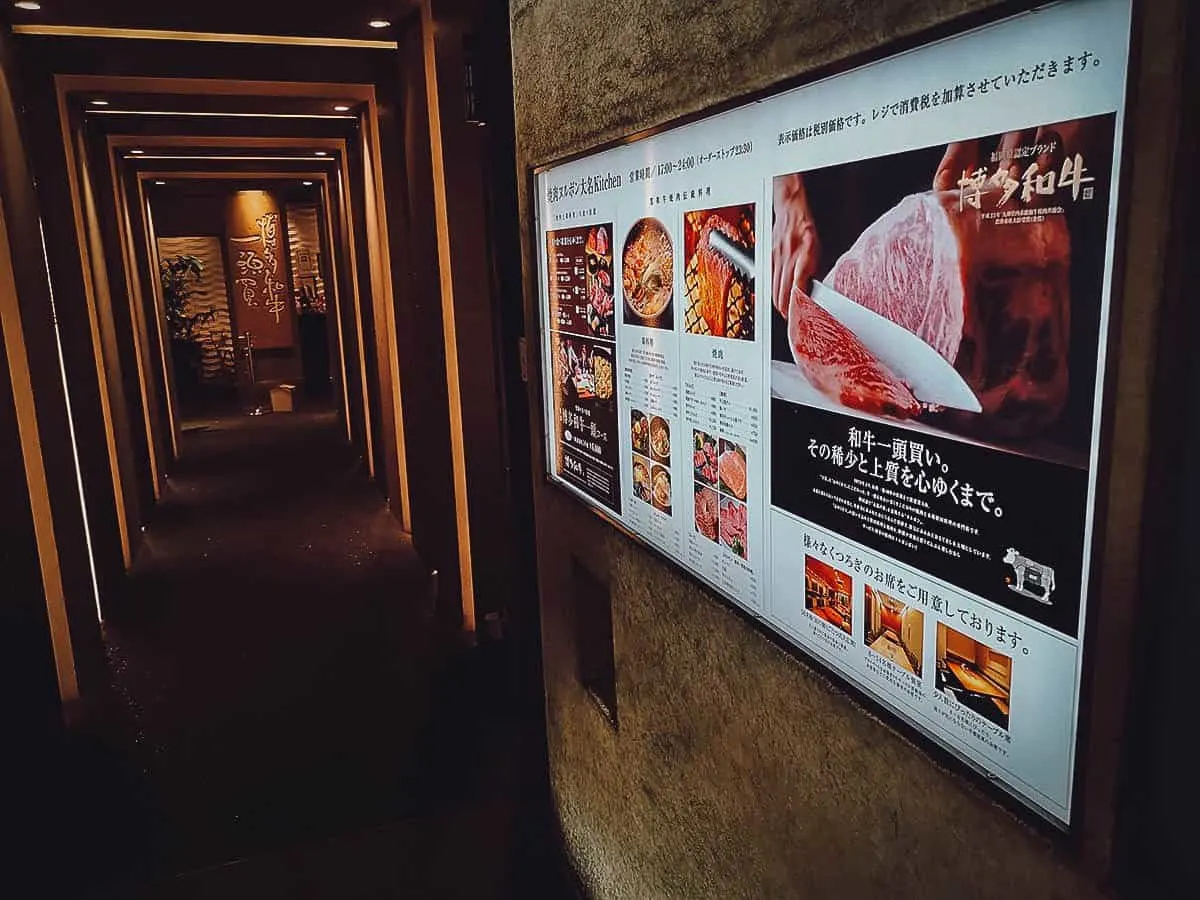
Our tour guide explained that this restaurant serves Hakata wagyu which they purchase by the whole cow. So unlike some restaurants that offer just certain types of meat, they’re known for serving a variety of premium cuts.
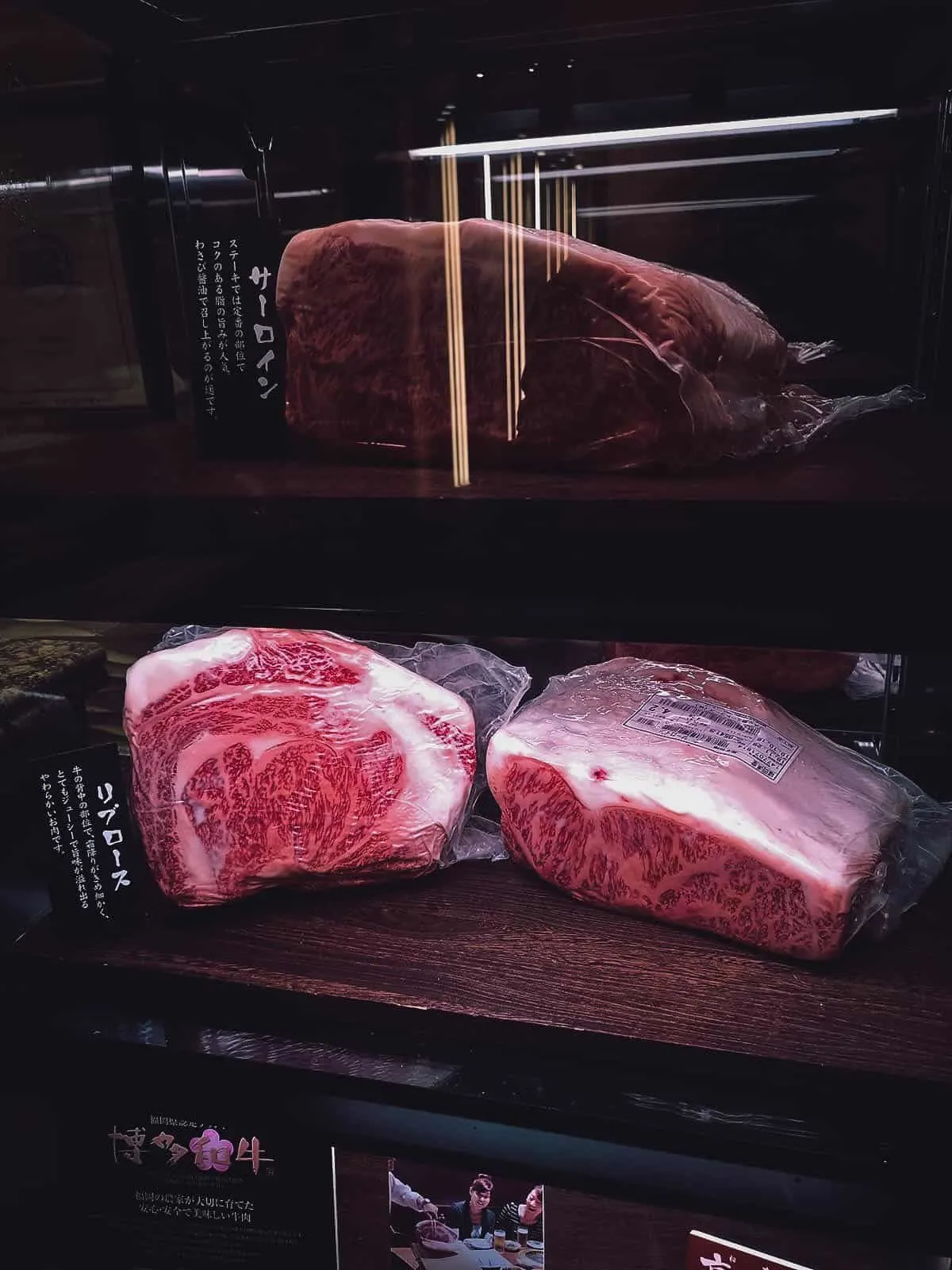
I don’t know what cuts these were but everything we had tonight was fantastic. I believe this was a mix of beef and pork. The pork was delicious but the beef was phenomenal. The meat was juicy and tender without any hint of gristle.
Japan brands its beef according to where the cows were raised, with some of the most prized brands being Kobe, Matsusaka, Ohmi, and Saga. I don’t believe Hakata wagyu is in the conversation for the most premium beef brands, but this only speaks to how good the quality of meat is in Japan. Highly regarded or not, this was some seriously delicious beef.
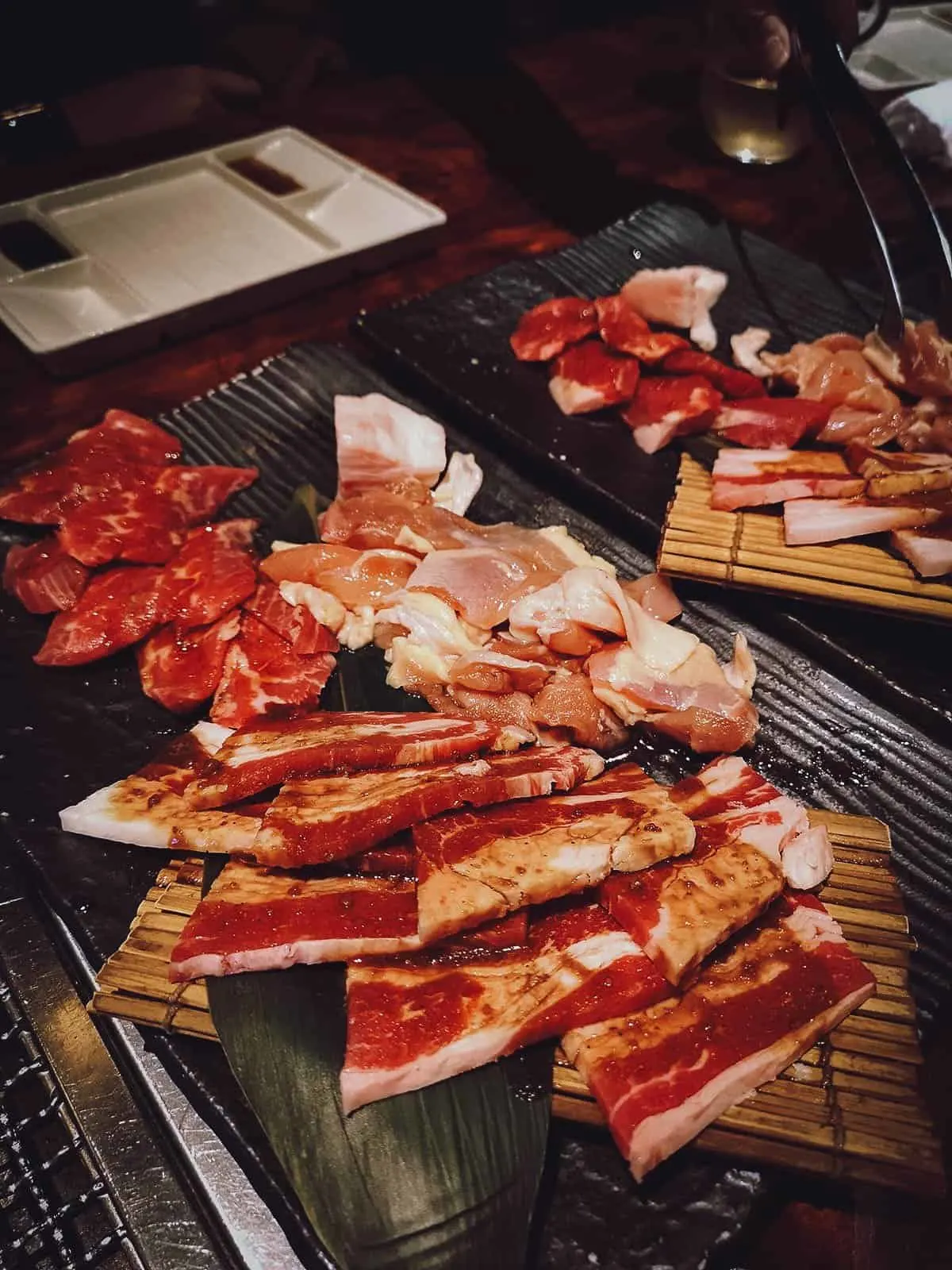
They say there are two types of people in the world – those who grill meat at yakiniku restaurants and those who wait for their meat to be grilled for them. Which one are you?
I believe we each had the Tsudoi course but Yakiniku Nurubon appears to offer multiple versions of their all-you-can-eat set menus. Depending on what course you choose, you can have as much as you want of certain types and cuts of meat.
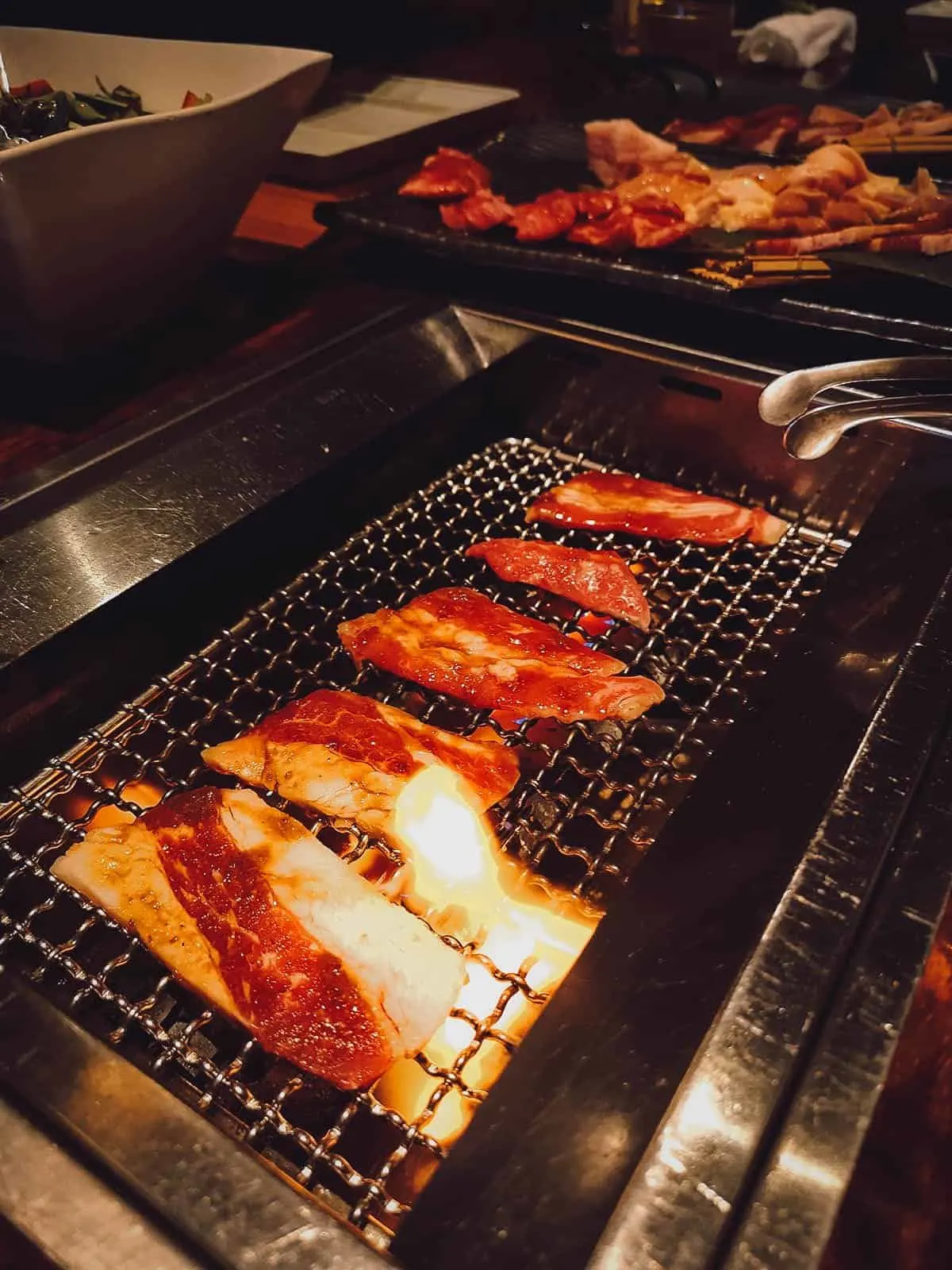
My beautifully charred piece of Hakata wagyu beef. This restaurant gives you two types of dipping sauce or tare, but the meat was delicious even on its own. Tender, smokey, savory, and a little sweet and crunchy from the caramelization, this was a terrific meal that really set the tone for the rest of the trip.
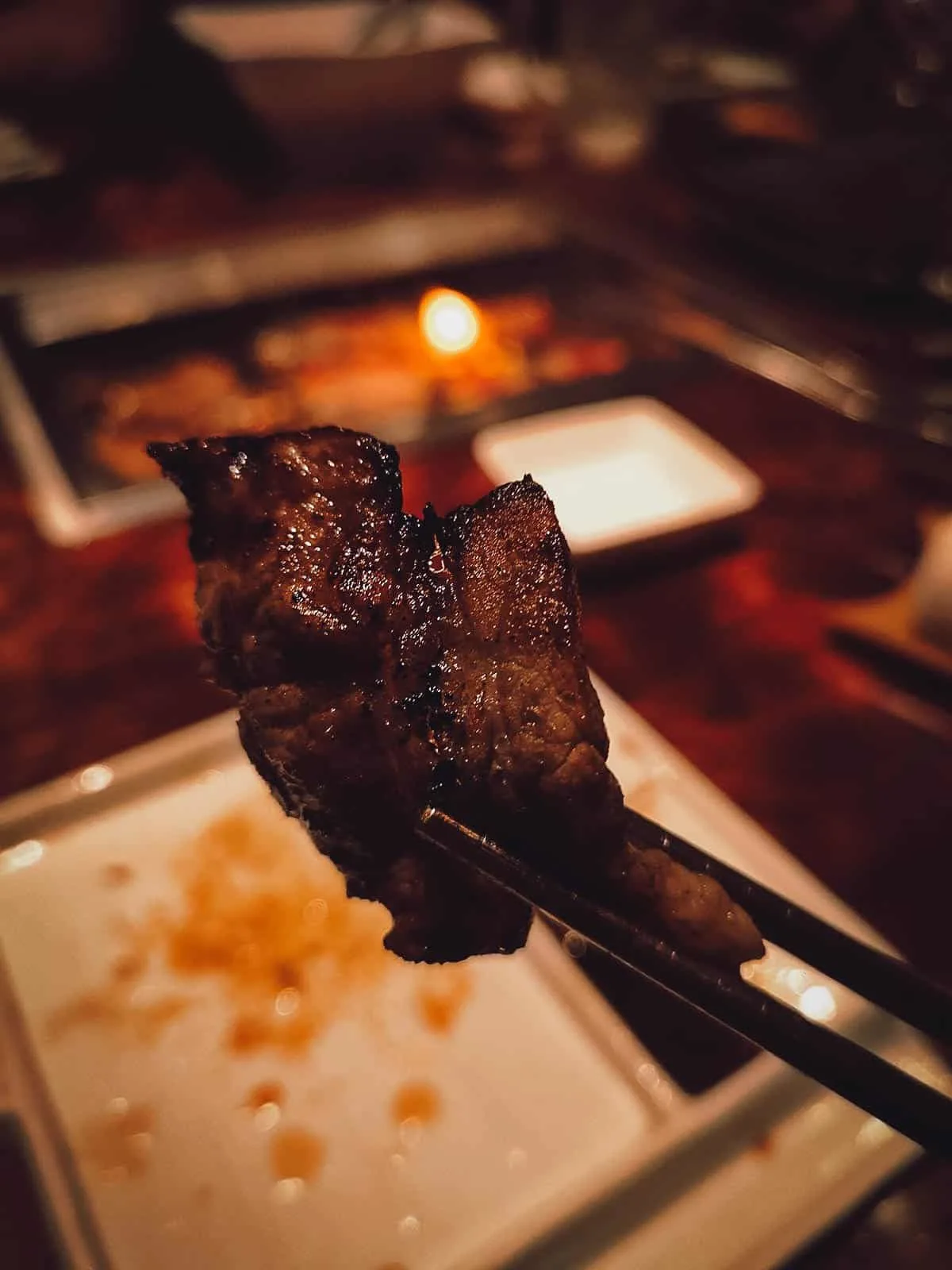
Remember what I said about many yakiniku restaurants in Japan offering kimchi? Yakiniku Nurubon offers other distinctly Korean dishes as well, like this bowl of naengmyeon. Naengmyeon is a North Korean dish of cold buckwheat noodles that became popular throughout the peninsula after the Korean War.
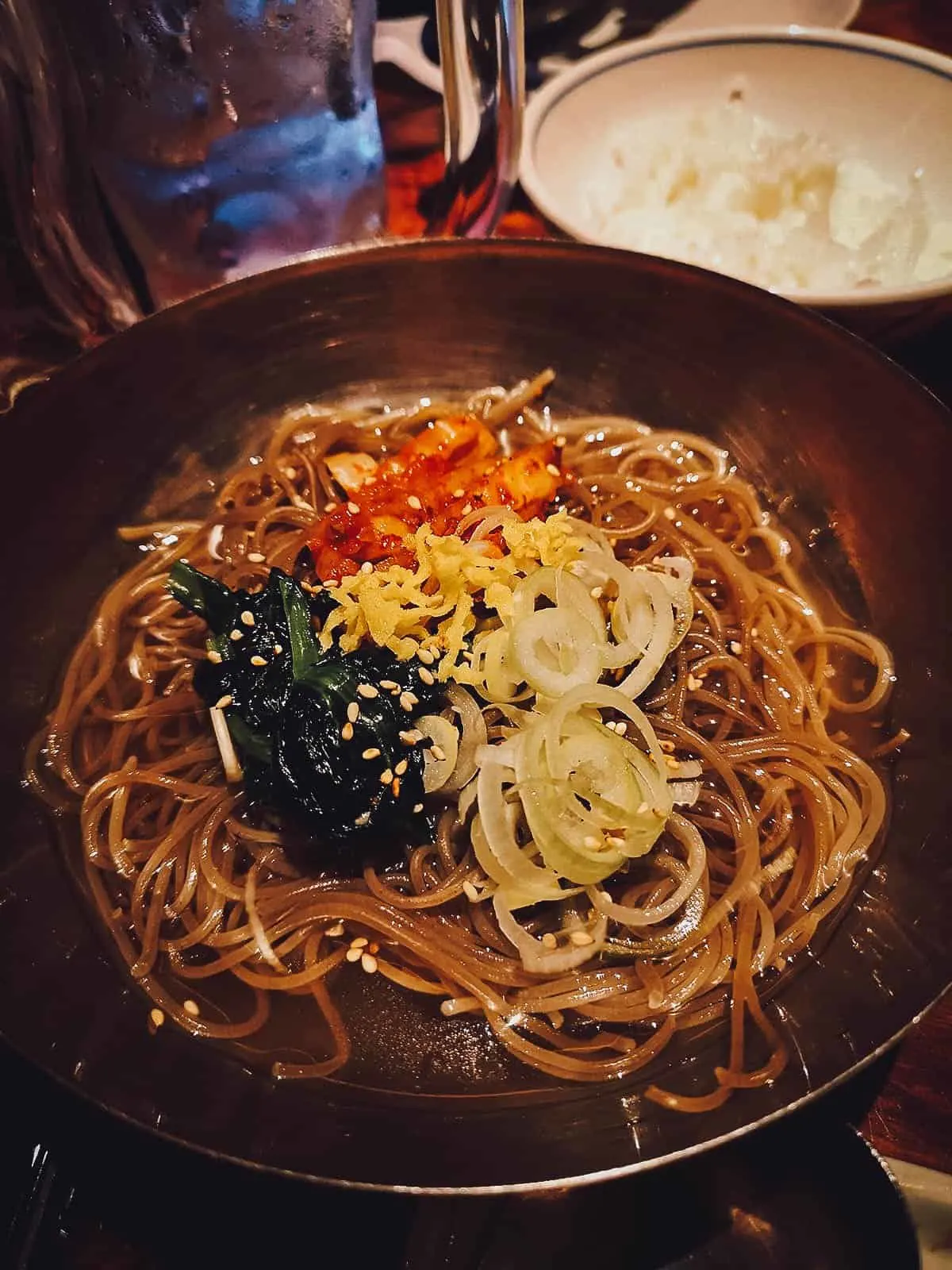
Naengmyeon is one of my favorite Korean dishes so I was pleasantly surprised to find it here.
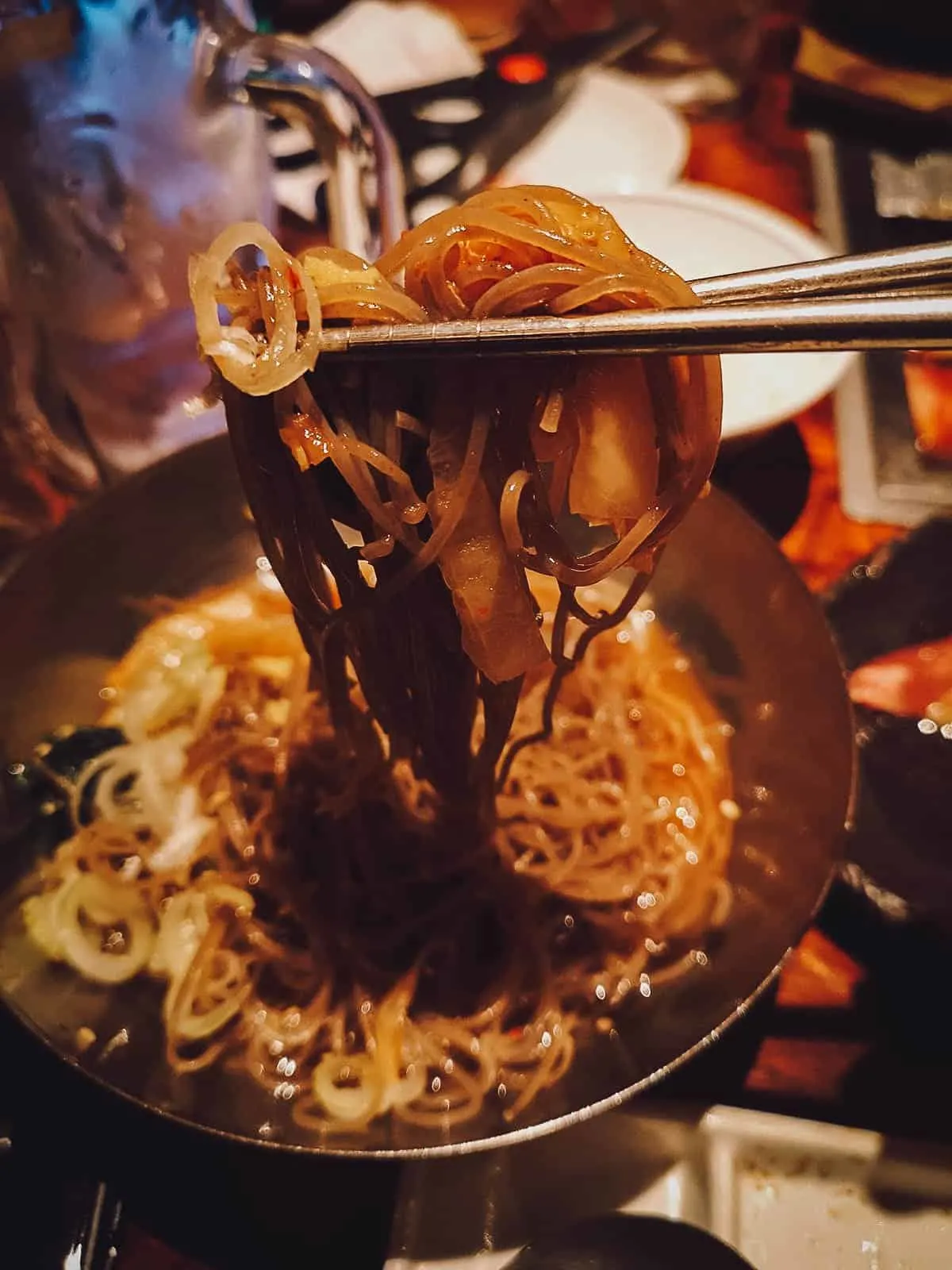
As described, Yakiniku Nurubon is popular so don’t plan on eating here without a reservation. Your hotel can probably help make a reservation for you.
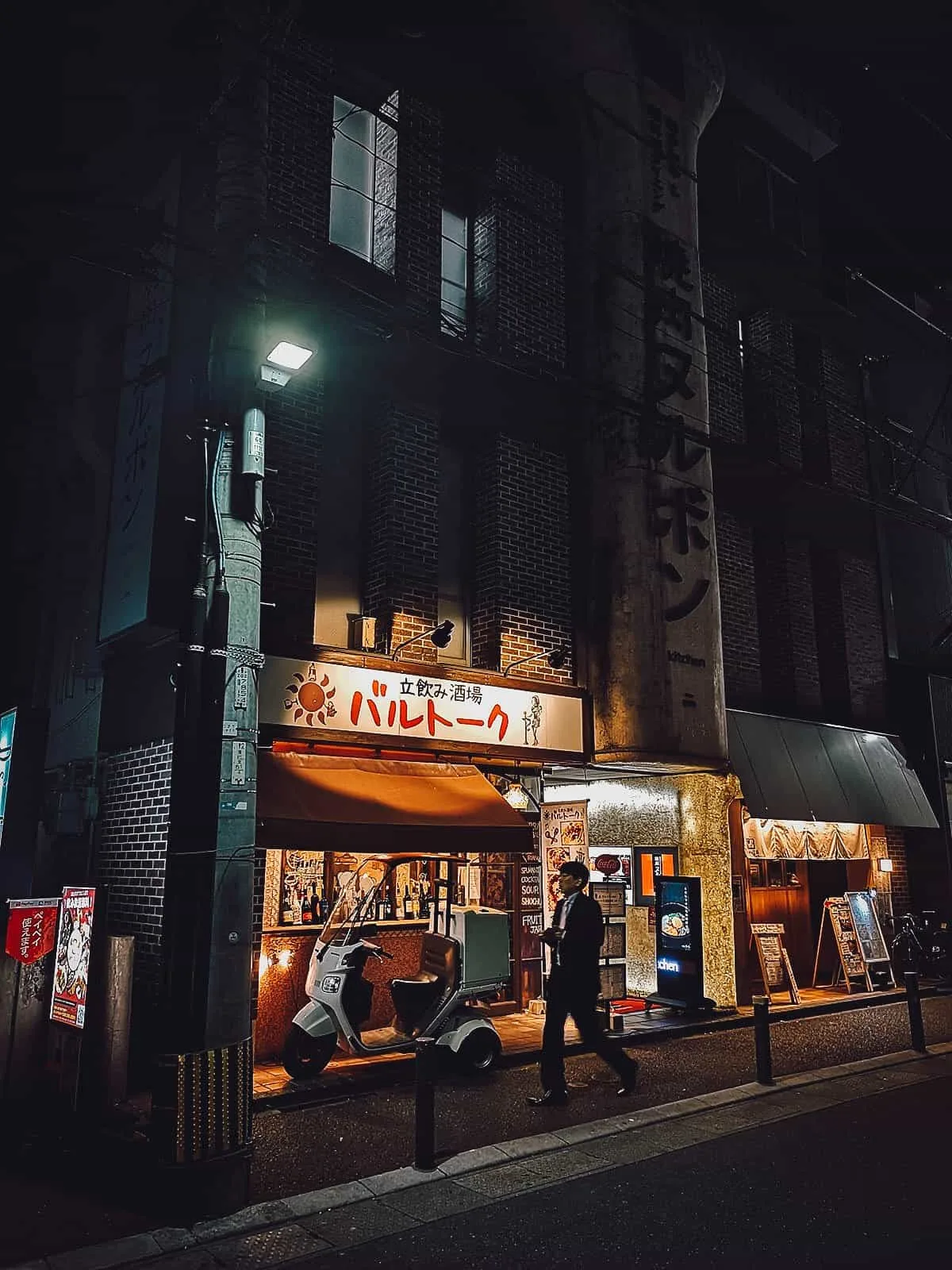
Yakiniku Nurubon
Address: 1 Chome-11-12 Daimyo, Chuo Ward, Fukuoka, 810-0041, Japan
Operating Hours: 5PM-12MN, daily
What to Order: Yakiniku
4. Yatai Stalls
Like yakiniku, yatai doesn’t refer to a specific dish but a dining concept. It refers to these tiny outdoor food stalls that open only at night, offering simple dishes like yakitori and Hakata ramen. You can think of them as Japanese street food stalls.
Yatai stalls can be found in many Japanese cities but Fukuoka has the most. The practice of selling food from mobile stands dates back to 17th century Japan, but yatai became popular during and immediately following WWII.
Like Hakata ramen, yatai stalls have become a popular symbol of the city. However, due to health concerns, I read that their number has been on a steady decline, though you can still find over a hundred scattered throughout Fukuoka City.
I didn’t go to one on this trip but we enjoyed a few beers and late night bar chow at a yatai stall in 2017.
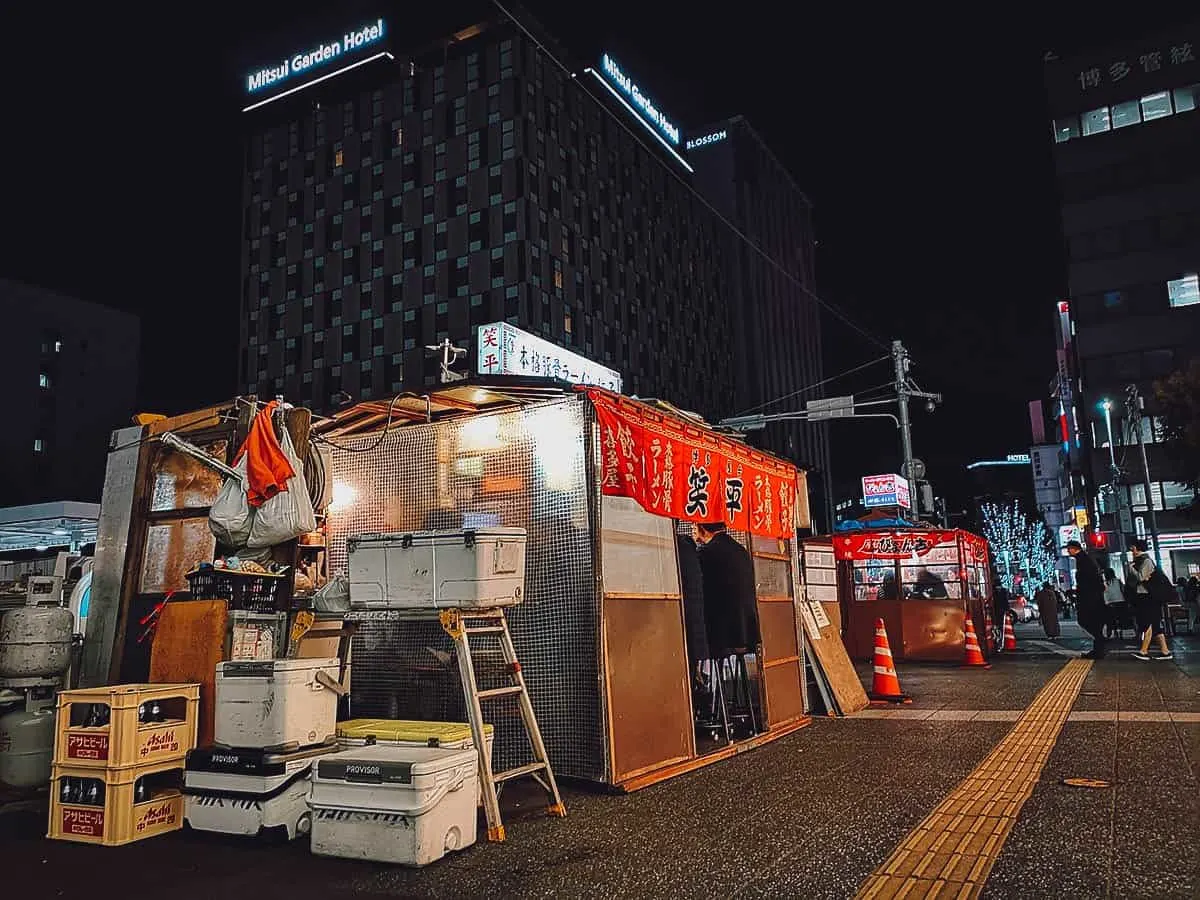
5. Persimmon
Japan has some of the best fruit in the world. The country has very little arable land – only about 12% – so to turn a profit, they’re forced to focus on quality, not quantity. Fruit orchards are small and the cost of living in Japan is high so they compensate by growing only the most premium fruit.
Have you ever walked into a depachika and seen those USD 200 melons? From Satonishiki cherries to Yubari melons to Amao strawberries, the fruits in Japan are of consistently high quality. These persimmon grown in the orchards of Kurume in Fukuoka prefecture are no exception.
Migita Orchard
September till December is persimmon season in Fukuoka so we were taken to Migita Orchard to do some persimmon picking. Located in Kurume which is located about an hour south of Fukuoka City, entrance to Migita Orchard is free but you’ll need to pay for any persimmon you decide to pick.
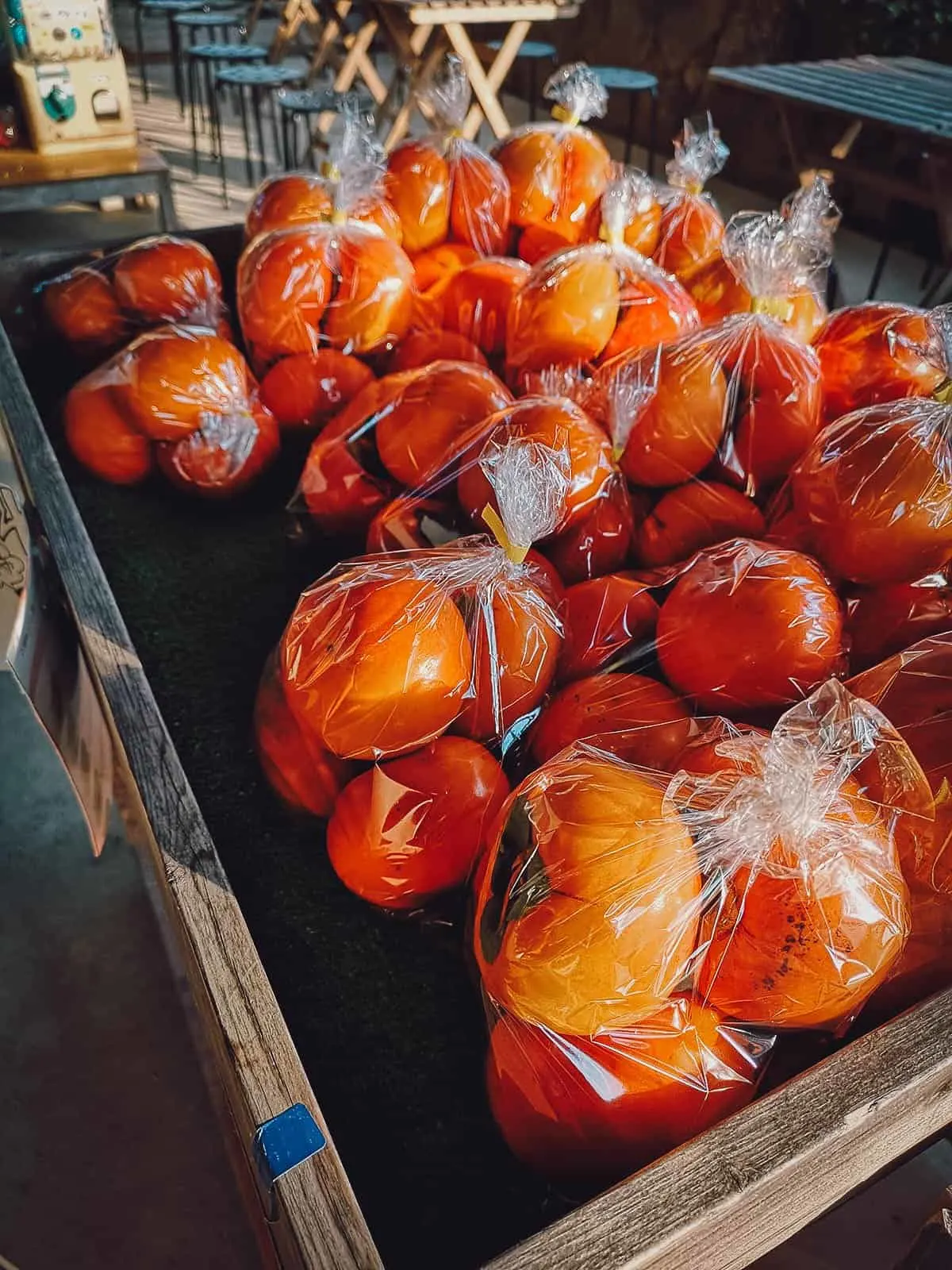
We were given shears and baskets and allowed to pick three persimmons each from the orchard. Their advice was to pick persimmons that were neither too hard nor too soft. Without any persimmon picking experience, they all felt pretty hard to me so I zeroed in on the most impeccable-looking fruit.
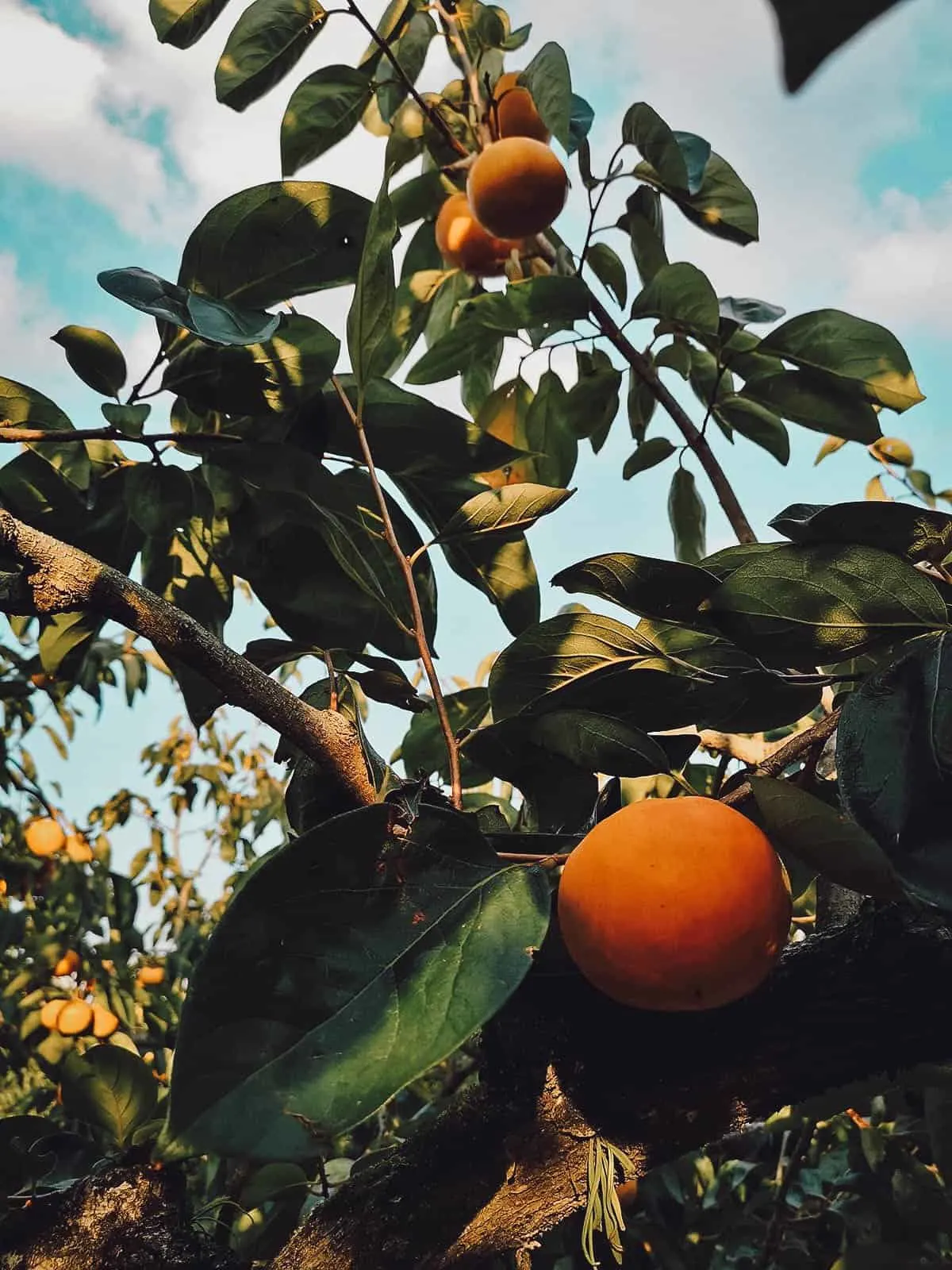
Here’s one. Aren’t persimmons pretty? They look like big orange tomatoes.
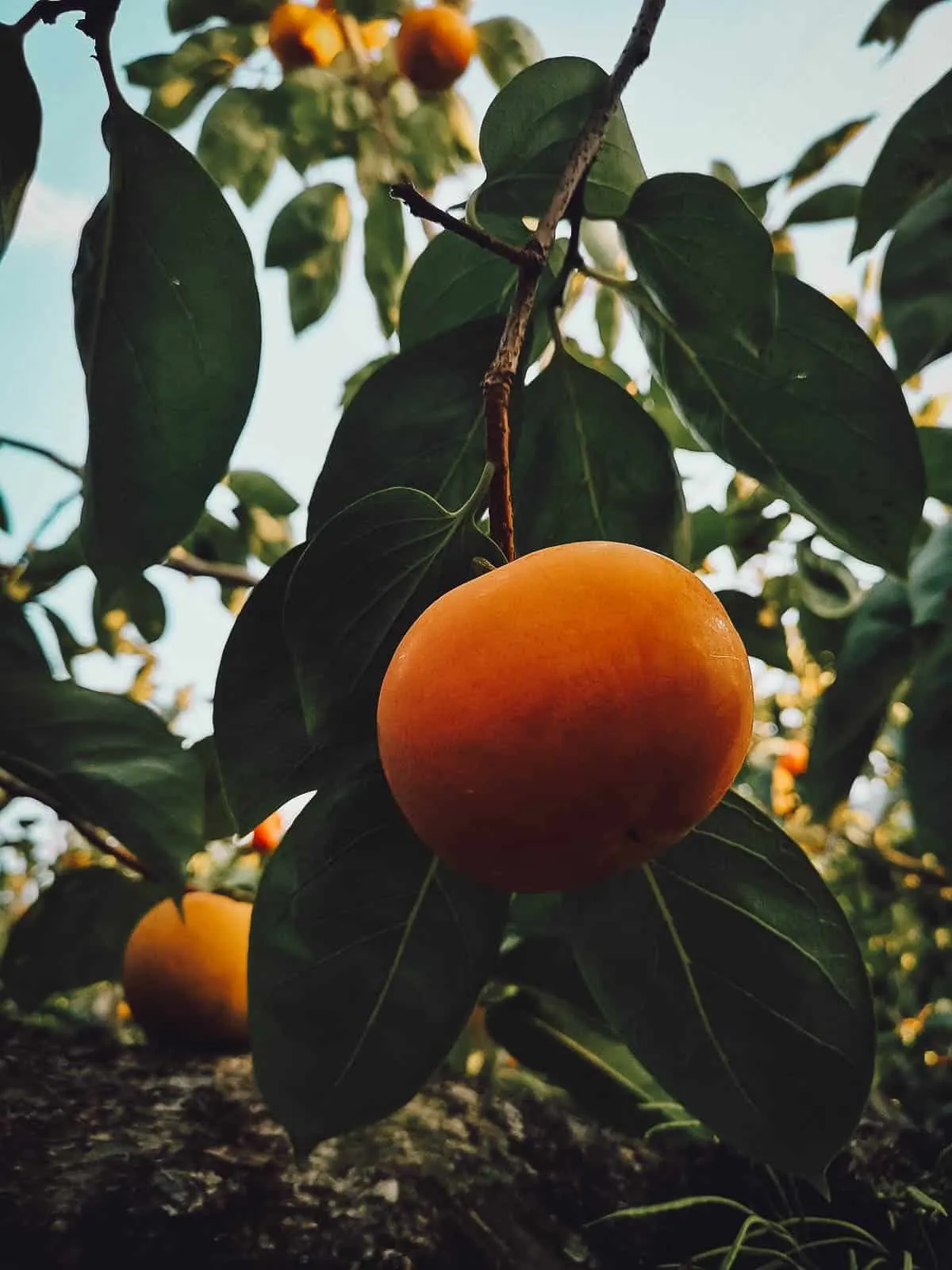
I had never tasted persimmons before so I didn’t know what to expect. I wasn’t too excited about picking them until I got my first taste. Persimmons are damn delicious. As my Japanese friend said, they taste just like autumn. You’ll know what I mean when you taste one in Japan.
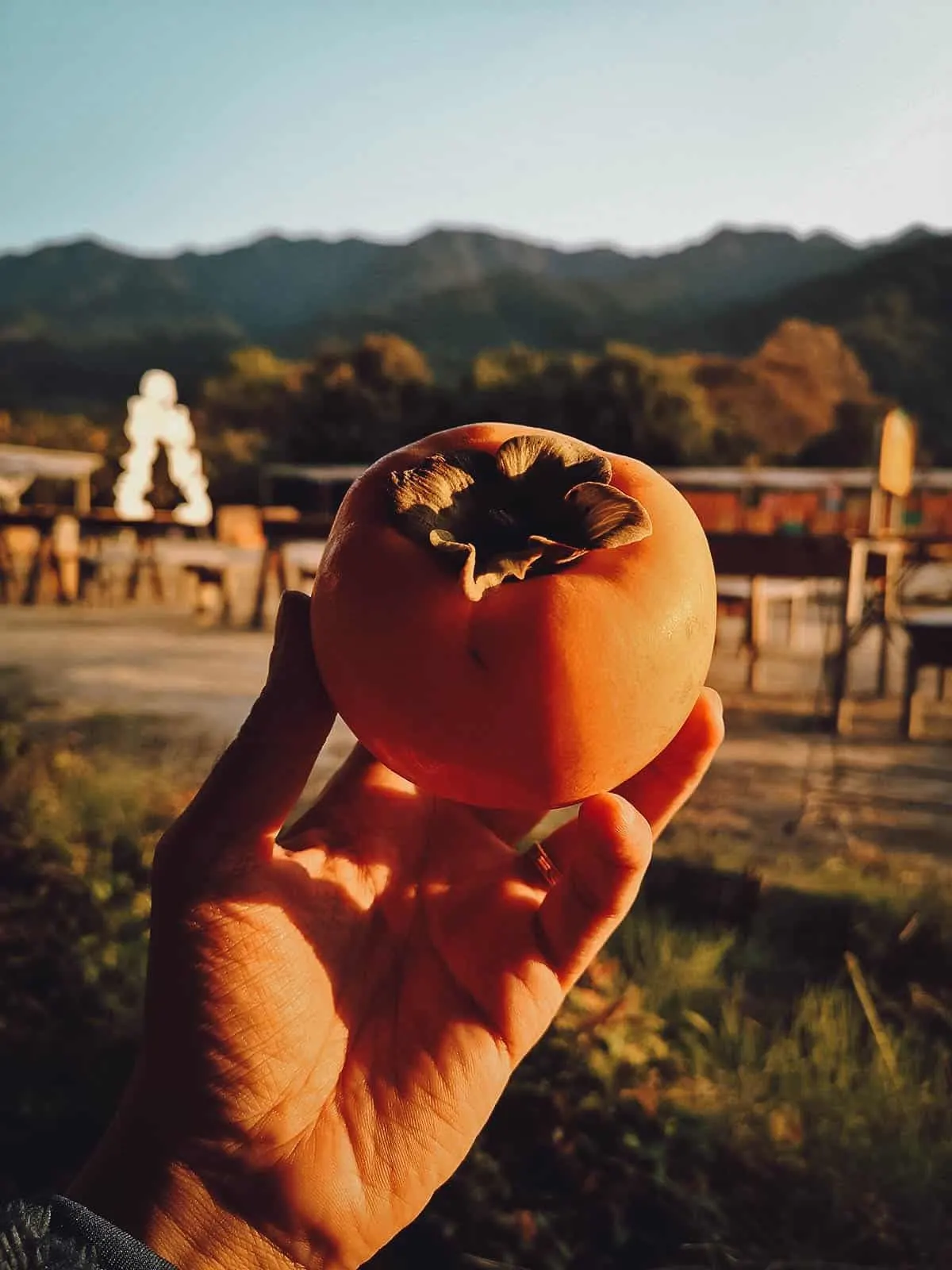
You can sort of guess what it’s going to taste like just by looking at it. It’s similar in taste and texture to a honeydew melon, but not exactly. It has an earthy sweetness to it if that makes any sense. It’s been two days since I got back from this FAM trip and we’re already down to out last persimmon. I wish I brought back more!
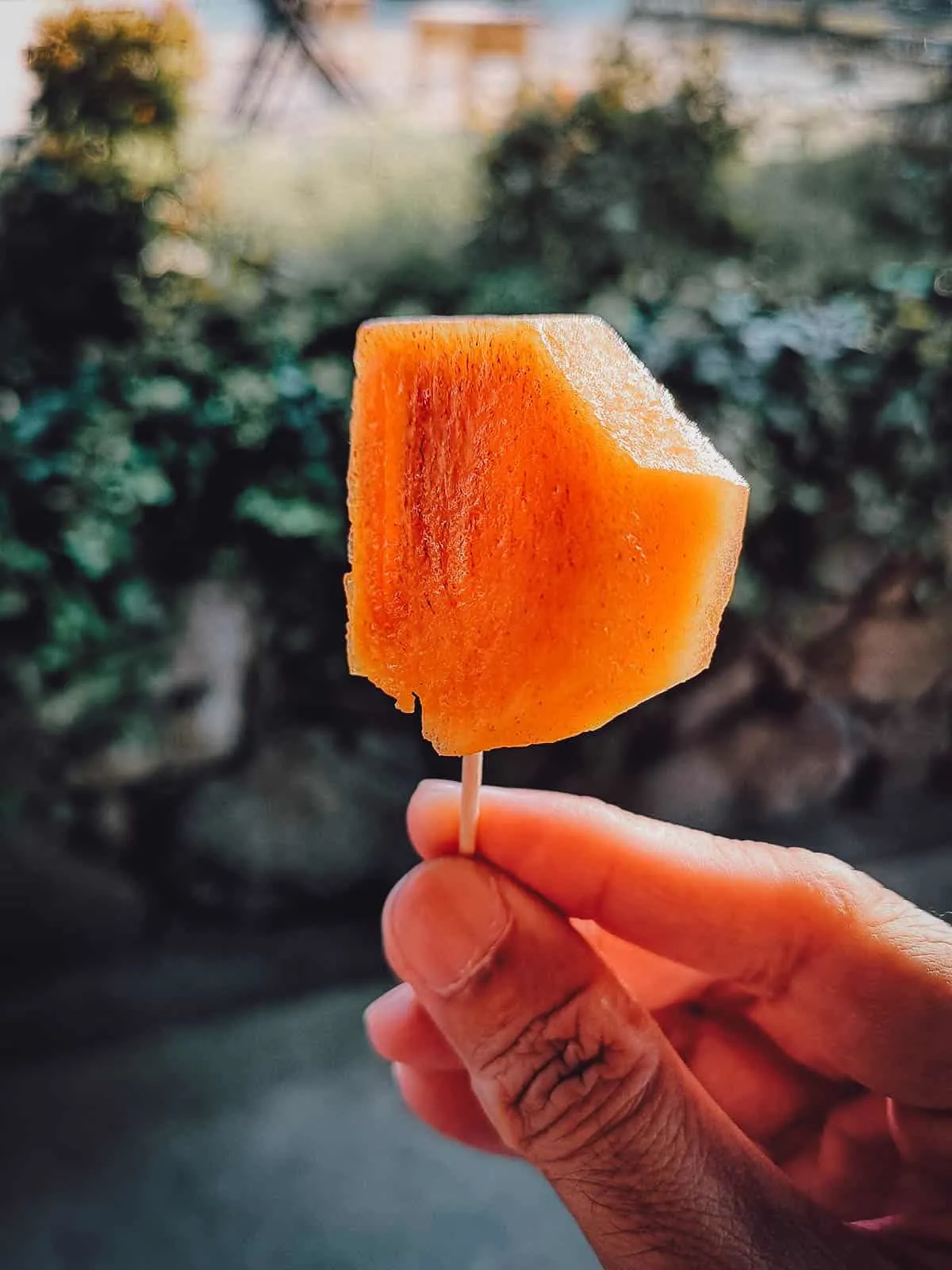
Migita Orchard
Address: 3024 Tanushimarumachi Chitoku, Kurume, Fukuoka 839-1214, Japan
Operating Hours: 9AM-5PM, daily
OITA
We visited Hita on this FAM trip, a city located in Oita prefecture. Oita is known for dishes like Bungo wagyu, buri no atsumeshi, and gomadashi udon, but the dish we’d try on this trip – hitsumabushi – is actually associated with Nagoya and Aichi prefecture.
I don’t know if it’s just coincidence, but I’ve had hitsumabushi only twice in Japan, and both times were in Oita prefecture. The first time was at a restaurant called Yufumabushi Shin Ekimae in the charming onsen town of Yufuin.
6. Hitsumabushi
Hitsumabushi refers to a Nagoya dish of grilled eel or unagi over rice. It looks like typical unagi donburi but differs in how the eel is cooked and eaten. It’s prepared in the Nagoya style of cooking eel – by slitting the fish open along the belly and grilling it whole without steaming.
Hitsumabushi is meant to be enjoyed in four stages, though it’s really just three. You’re advised to enjoy the first portion as is so you get a sense of what the eel tastes like on its own; the second with condiments like wasabi, grated radish, and nori; and the third with green tea or dashi broth poured into your bowl. Whatever is left you’re free to enjoy in whichever way you enjoyed best.
Hita Mabushi Senya
Hita Mabushi Senya is a restaurant in historic Mamedamachi Town in Hita City. This striking bowl of hitsumabushi was without a doubt the single best thing I ate on this FAM trip to northern Kyushu.
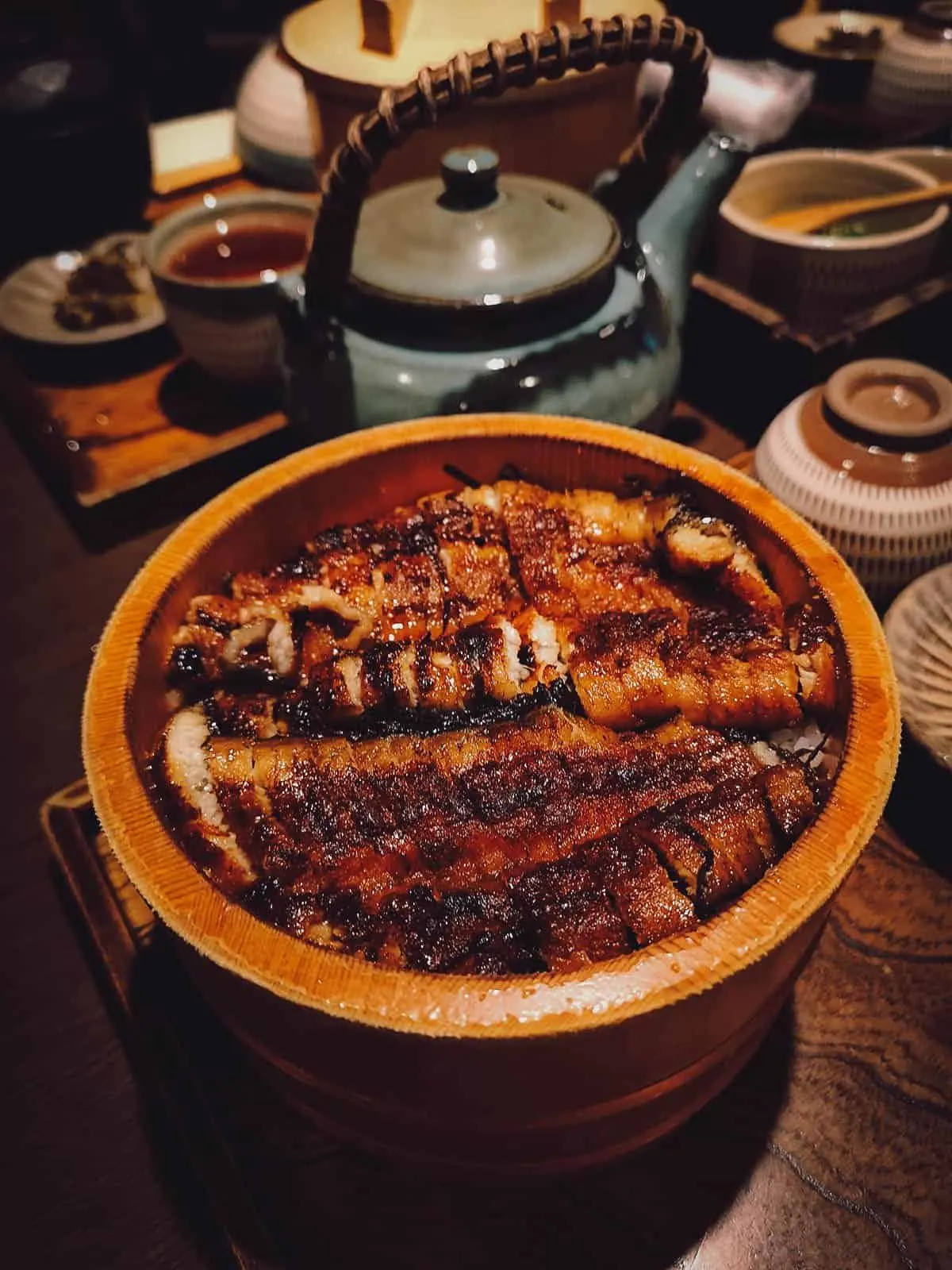
The beautiful and irresistible charred surface of grilled eel. It’s one of my absolute favorite foods in the world and something I yearn for on every return trip to this country.
Unagi is good anywhere but as you’d expect, it’s on another level in Japan. I just love its smokey sweet flavor and its charred but soft and delicately chewy texture. In other countries, they often drench the eel in too much sauce but not in Japan. They put just the right amount to give it sweetness without drowning out the natural flavors of the eel.
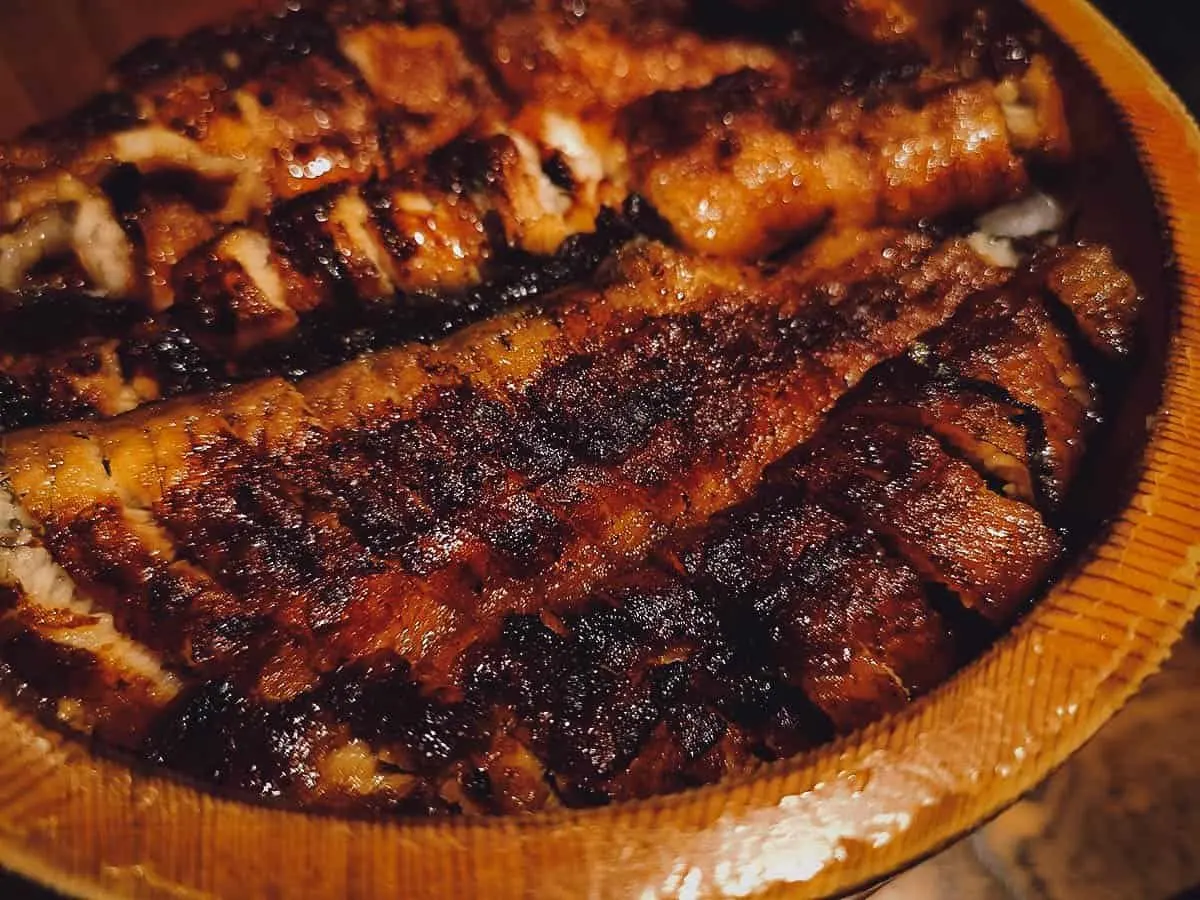
In the first stage, you’re meant to eat the eel and rice on their own. This for me, is the best way to enjoy unagi.
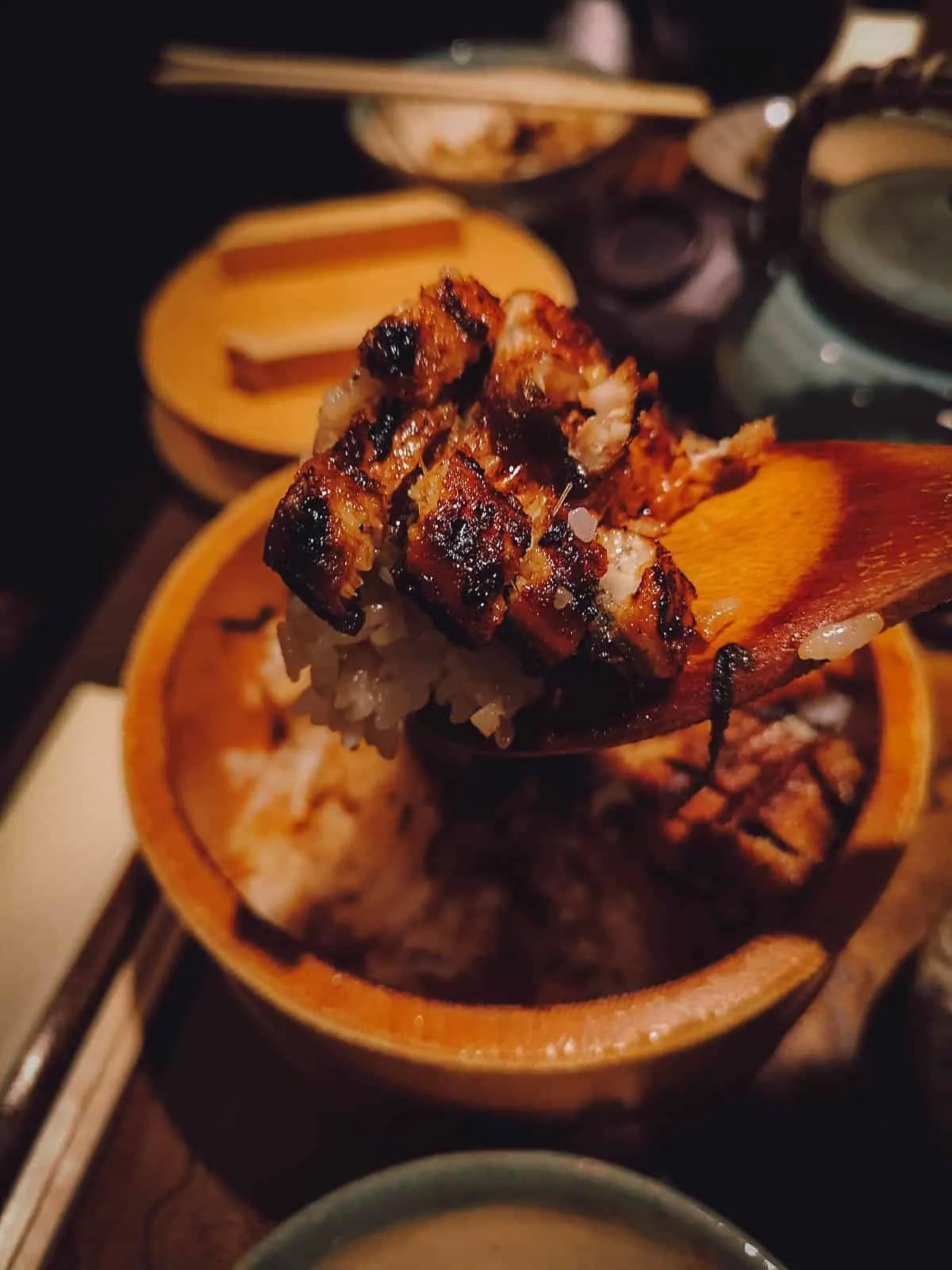
You can’t really see it but this is a picture of the second stage, with the eel and rice mixed with condiments like wasabi, radish, and yuzu. It was good but like I said, grilled eel with a light brushing of eel sauce is already perfect for me.
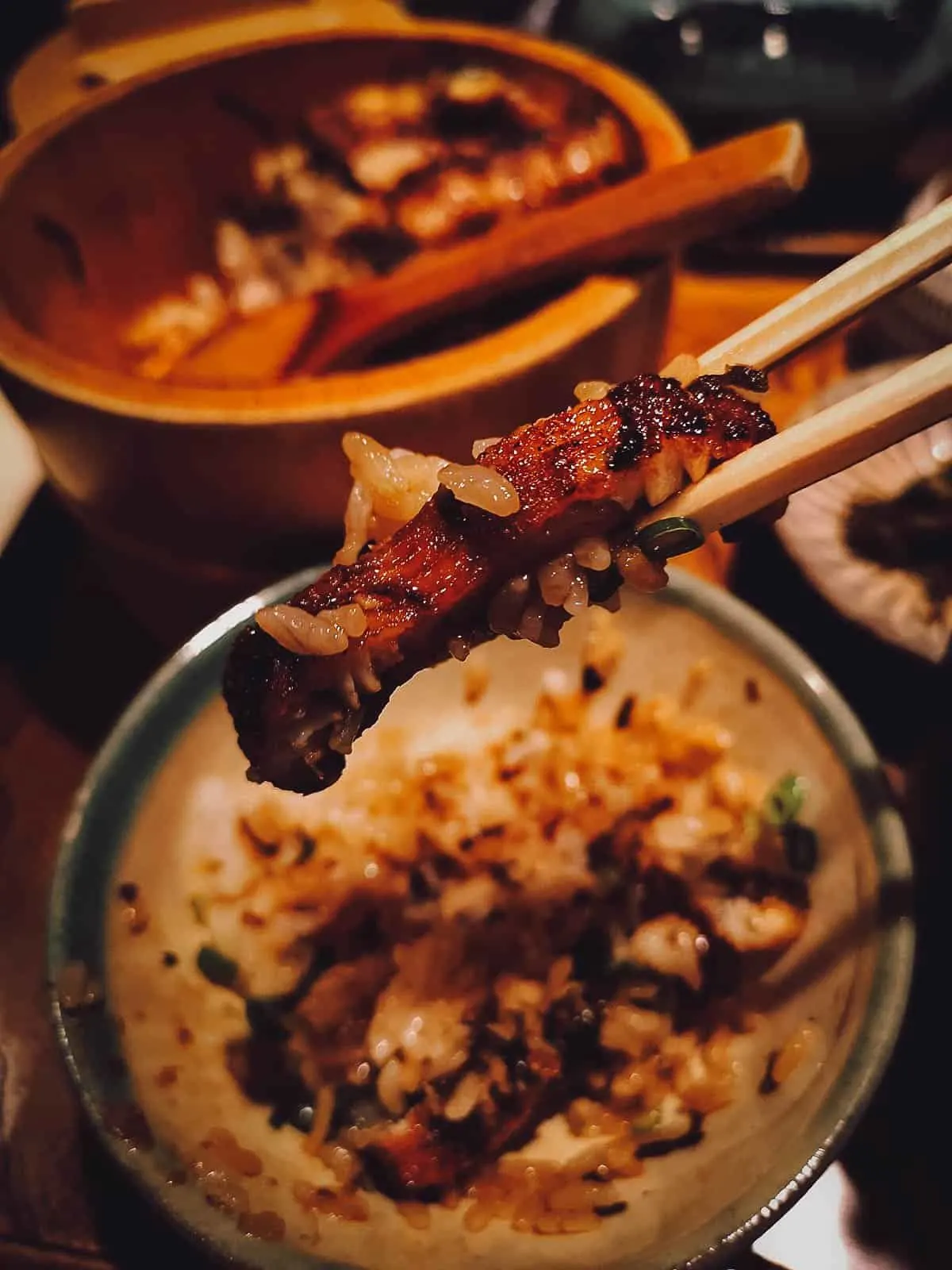
The third stage with dashi is my least favorite of the three so I enjoyed only a small portion of the eel like that. I ate most of it like this, on its own with no condiments.
One of the bloggers in our group was a vegetarian so we had an extra order of hitsumabushi to go around. Everyone was already full so I took most of it for myself. Nearly two servings of hitsumabushi in one sitting. Cebu Pacific, I love you.
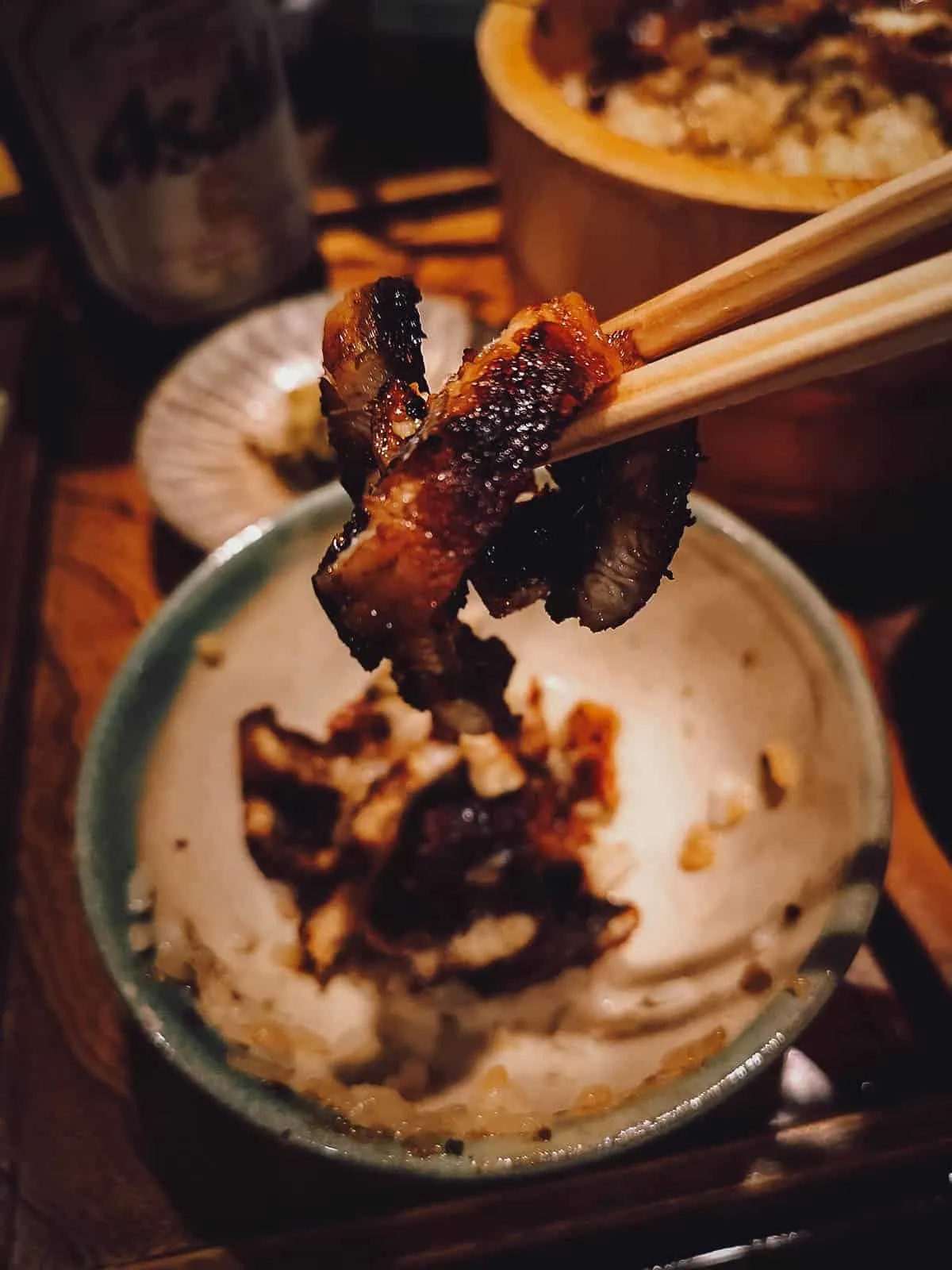
Here’s something you don’t see everyday. Can you guess what they are? They’re packets of dry roasted eel bone “chips”. I was too full to be interested in more food at this point but in hindsight, I wish I had brought back a few of these packets. They look like they make good bar chow.
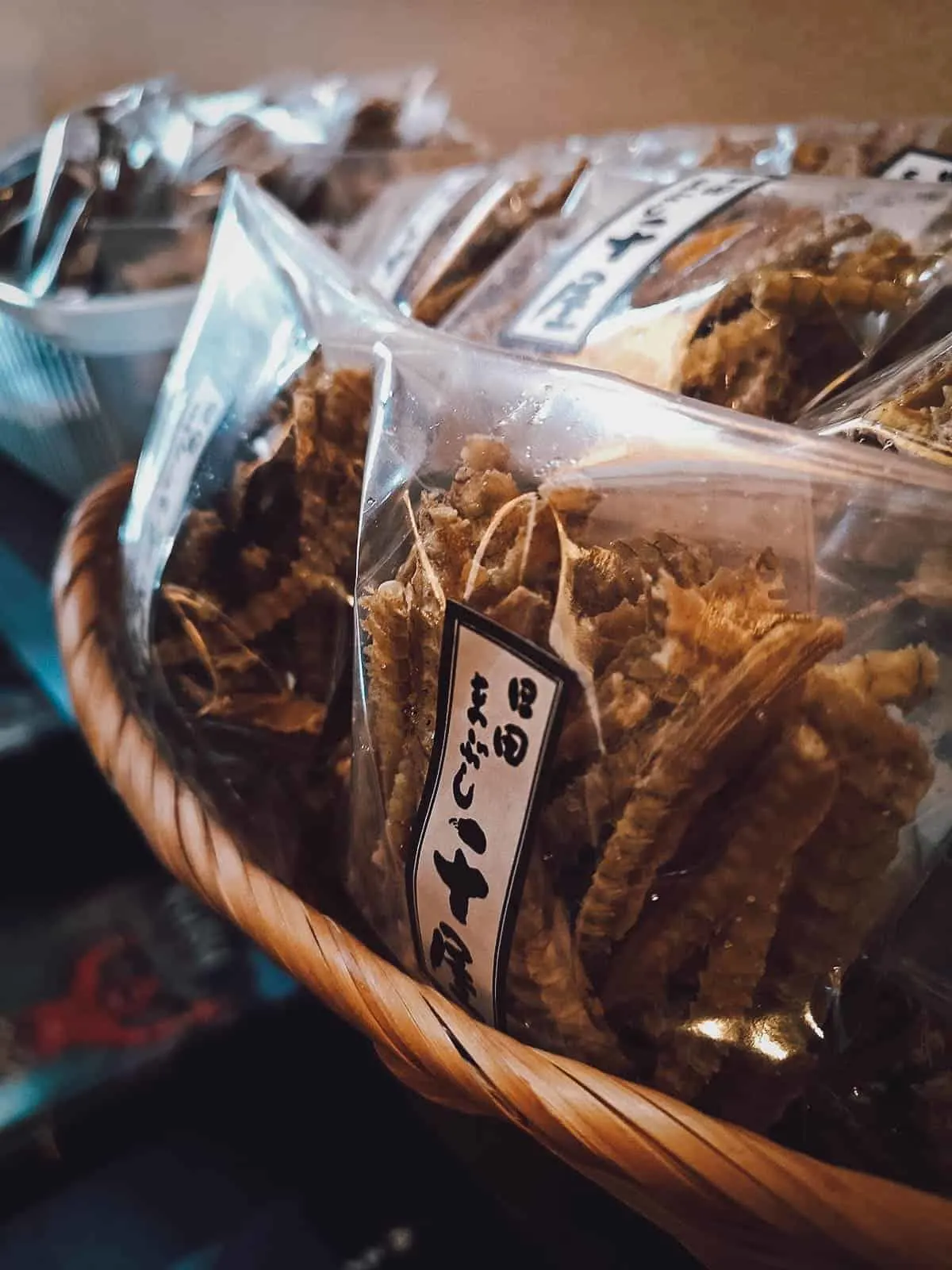
Hita Mabushi Senya is located along the main road of charming Mamedamachi. They’re a TripAdvisor Certificate of Excellence awardee with a near perfect 4.5-star rating. If you like eel, then you definitely need to eat here should you ever find yourself in Mamedamachi.
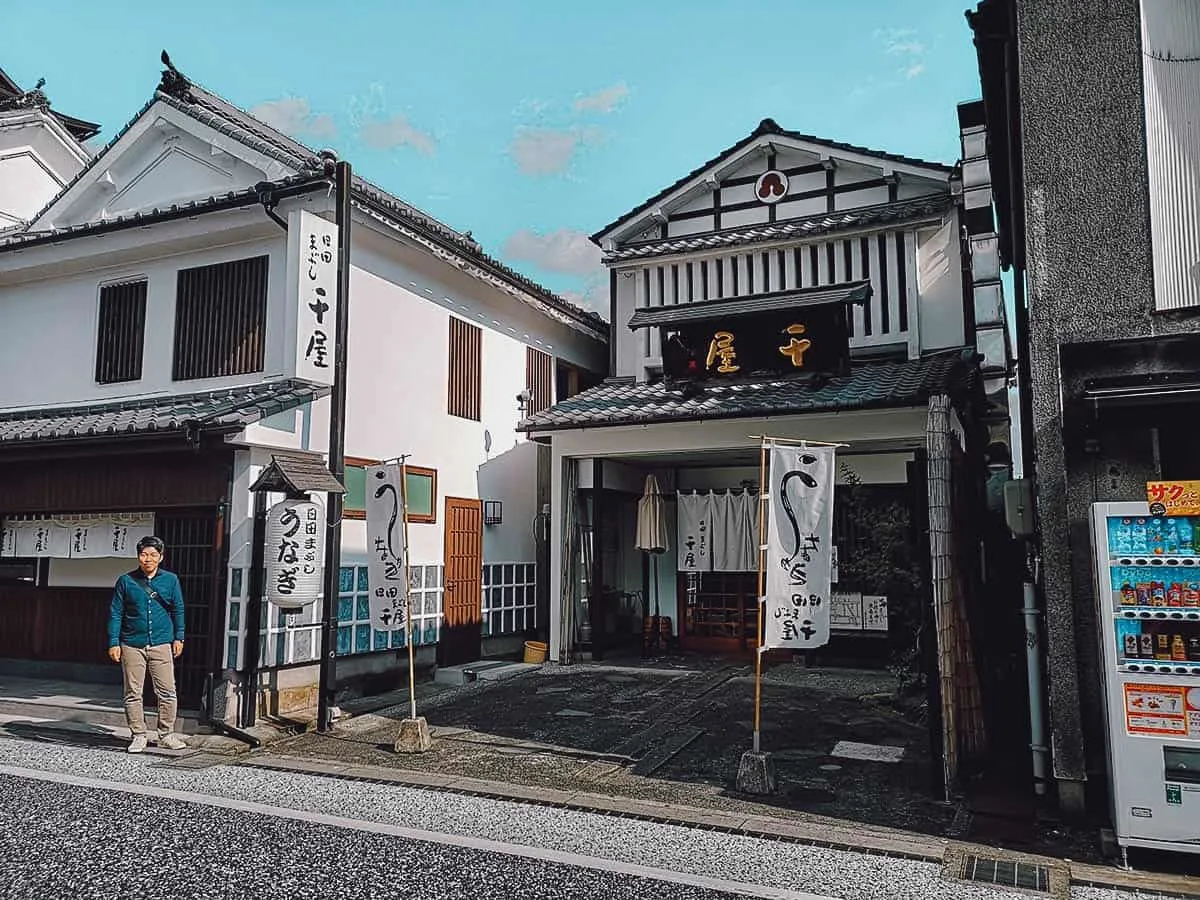
Hita Mabushi Senya
Address: 4-14 Mamedamachi, Hita, Oita 877-0005, Japan
What to Order: Hitsumabushi
Operating Hours: 11AM-5PM, Mon-Fri / 11AM-8PM, Sat-Sun
7. Sake
No trip to Japan can ever be complete without downing a few shots of sake or Japanese rice wine. Made from fermented rice, it’s Japan’s national beverage. It’s popular throughout the country and can be served chilled, warm, or at room temperature.
Kuncho Sake Brewery
After polishing off our bowls of hitsumabushi, we walked to Kuncho Sake Brewery for some free sake tastings. Established in 1703, this brewery is well over 300 years old.
They were offering tastings of two types of sake today, the first being this cloudy or milky-looking sake. A Japanese friend of mine gave us a bottle of this type of sake before so I’m a little familiar with it. I believe it’s called nigorizake or unfiltered sake. The rice sediment at the bottom turns the liquid cloudy when the bottle is shaken before the sake is served.
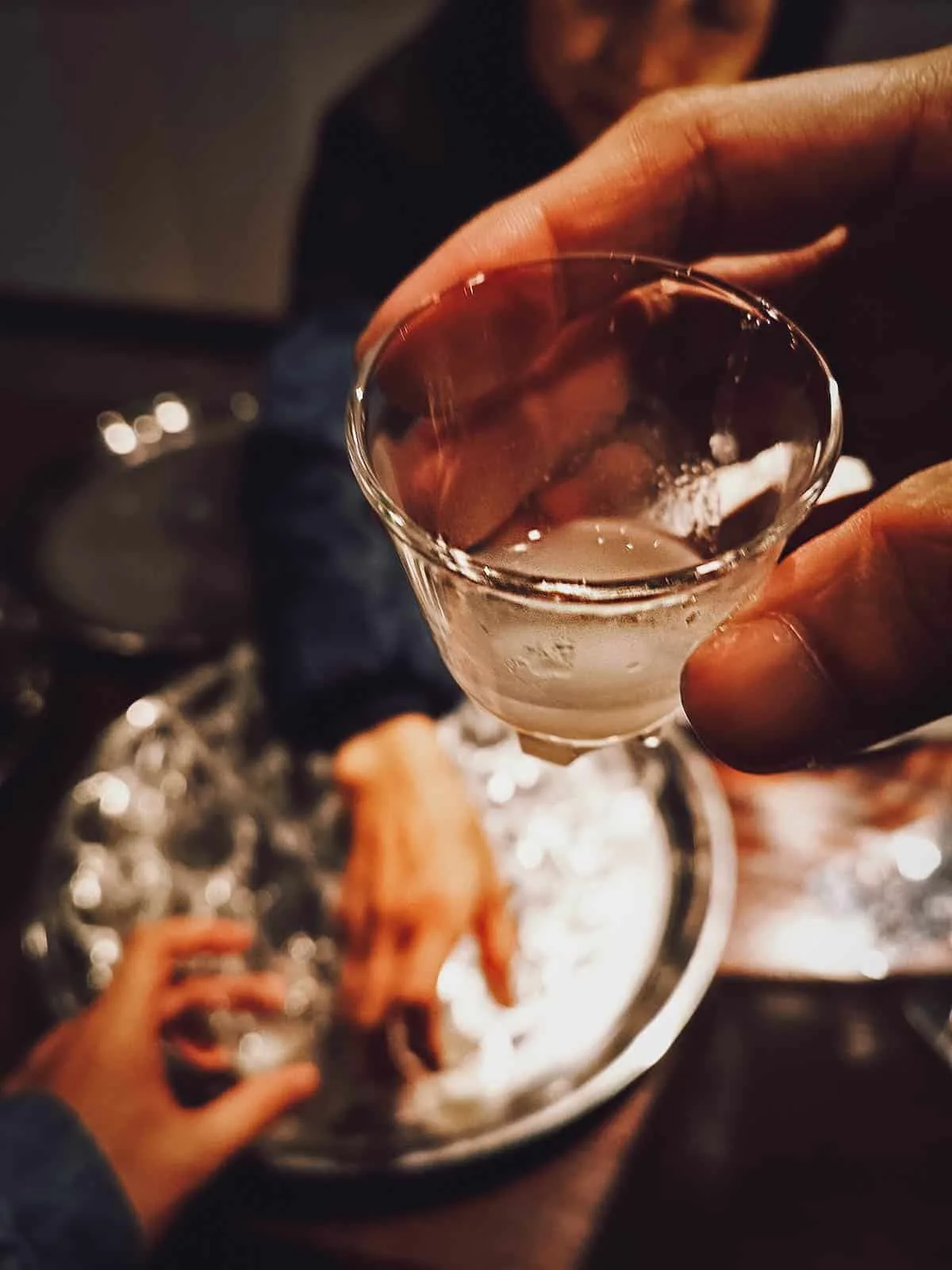
Here’s a more familiar type of clear sake. I know little about sake so I don’t know what kind this was. Like wine, there seems to be many types. I’ll be taking a sake tasting tour in Kyoto in February so I’m looking forward to learning more about this drink that’s a vital component in Japanese culture.
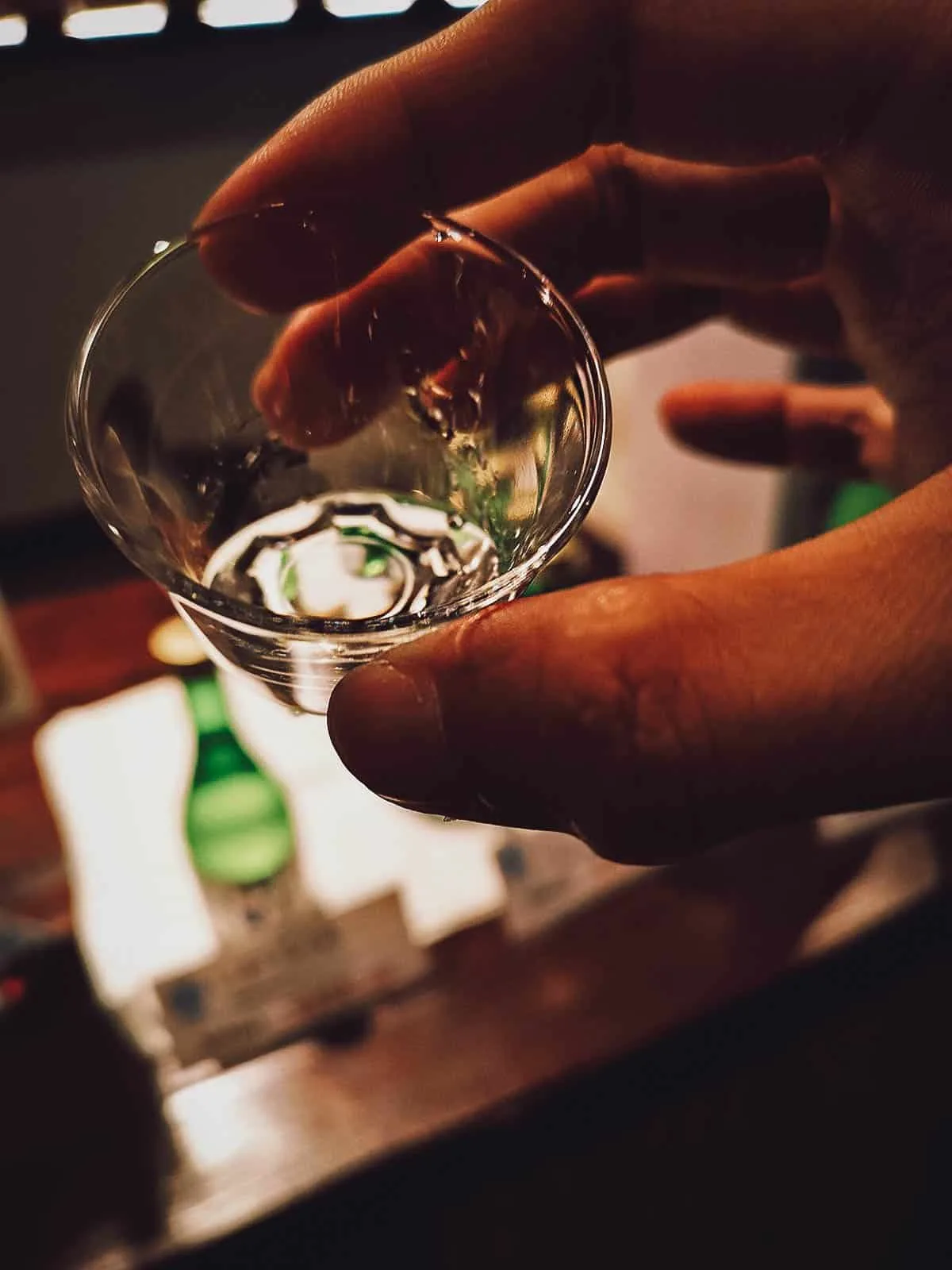
There’s a small museum inside Kuncho Sake Brewery as well. You’re free to enter and explore it on your own. I believe they offer factory tours as well.
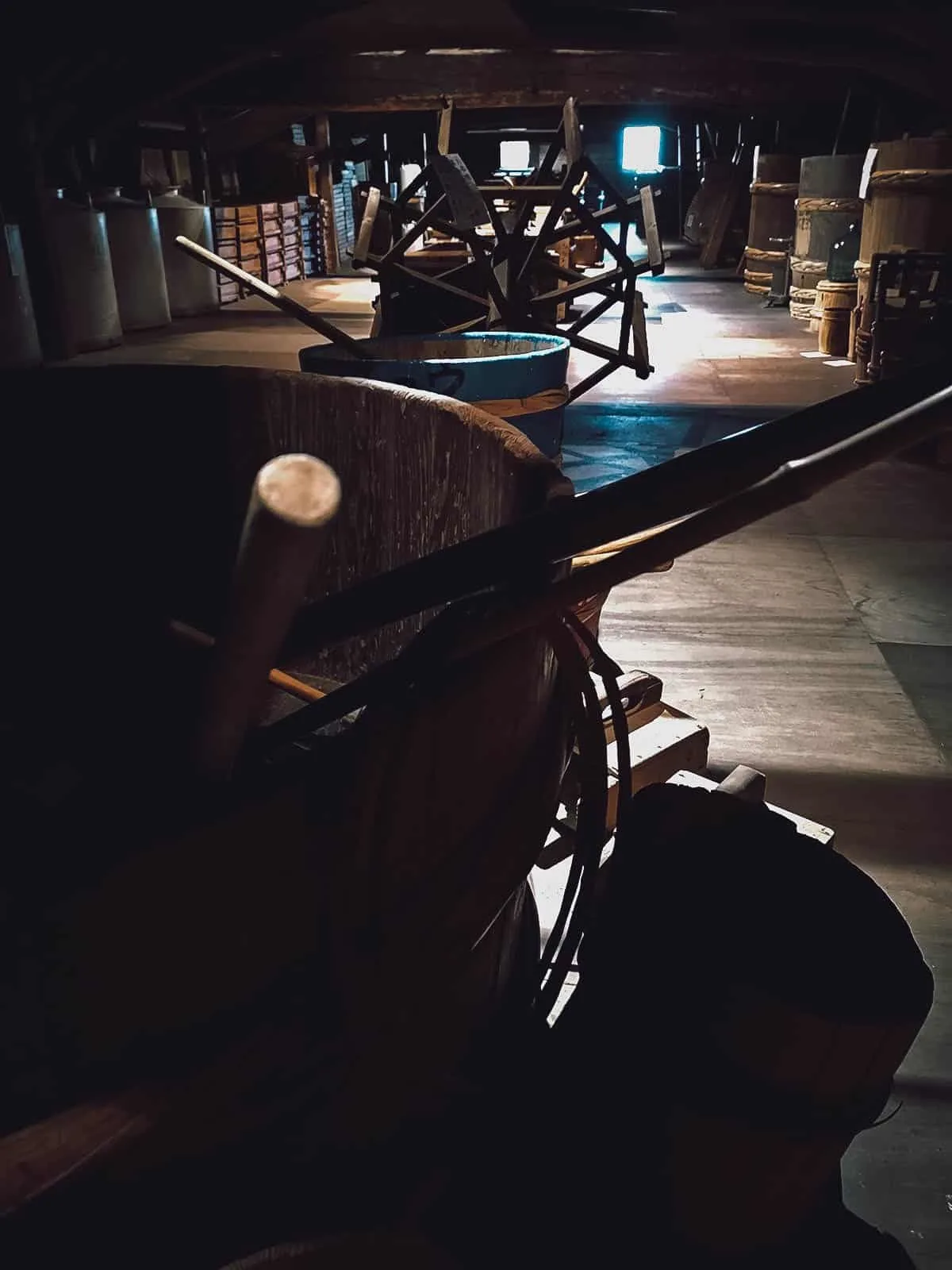
The natural light streaming through the window and into the museum made for some pretty sweet shots.
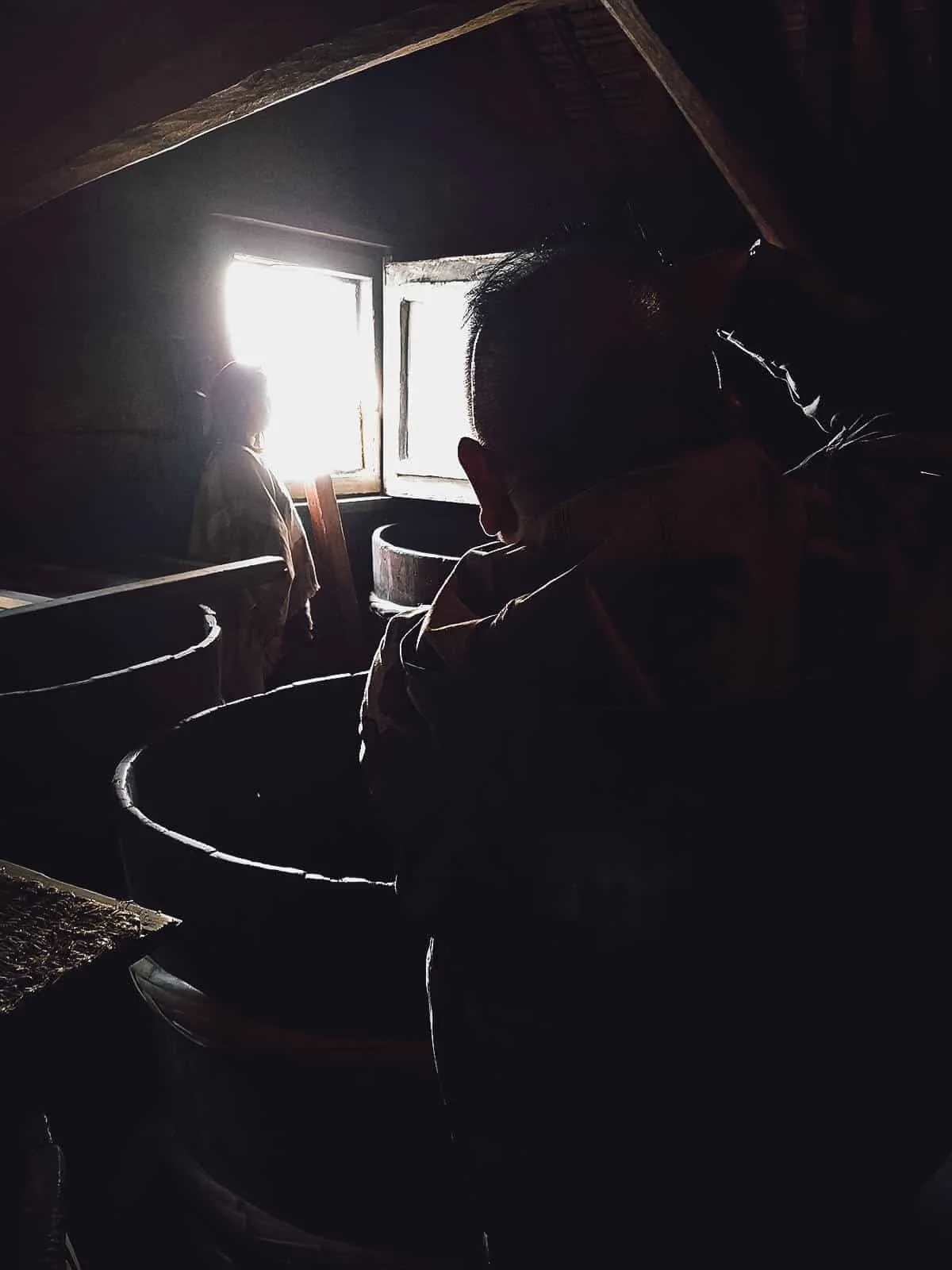
Kuncho Sake Brewery
Address: 6-31 Mamedamachi, Hita, Oita 877-0005, Japan
Operating Hours: 9AM-4:30PM, daily
NAGASAKI
Nagasaki is one of the strangest cities we’ve visited in Japan. It’s strange in the sense that it feels quite different from the rest of the country.
The architecture has strong European influences and the food is the most “un-Japanese” we’ve experienced so far. Many of Nagasaki’s core dishes are foreign in origin. Champon and kakuni manju are Chinese while castella cake – the city’s de facto food souvenir – is Portuguese. Google “shippoku” and you’ll find the ultimate hybrid of Japanese, Chinese and European cuisines.
This is because Nagasaki was the only city in Japan that stayed open to foreign trade from the 16th to the 19th centuries. Most people only know about the atomic bomb but there’s so much more to this city than that.
8. Toruko Rice
This is one of the oddest dishes I’ve tried in Japan. When you first look at it, it doesn’t seem like a traditional Japanese dish but it is, at least here in Nagasaki.
Toruko rice or turkey rice is a dish of rice pilaf, tonkatsu (pork cutlet), and Neapolitan spaghetti. As you can probably tell from its components, the dish has nothing to do with the bird nor the country, which makes its name even more mystifying than the dish itself.
According to our guide, no one seems to know why it’s called “turkey rice” but one popular theory points to the colors of the dish as a potential clue. Some people surmise that the three components of the dish resemble a tricolor flag. “Tricolor” was truncated to toruko which means “turkey” in Japanese.
Whatever its origin, toruko rice is an interesting albeit somewhat strange dish. I learned about it on our first trip two years ago but found the combination too odd so I left it off our itinerary. I’m happy I was able to try it on this trip as it speaks volumes about Nagasaki’s diverse culinary heritage.
Dejima International Club Restaurant
We tried toruko rice at the restaurant inside Dejima, an artificial island and former Dutch trading post in Nagasaki. According to our guide, Dejima at one point was the only place in the world that flew the Dutch flag. This was at a time when the Netherlands were invaded and annexed by the French.
As for the toruko rice, it tastes exactly how it looks – nutty and herb-y rice with a crunchy, savory-sweet pork cutlet and a side of tomato tangy spaghetti.
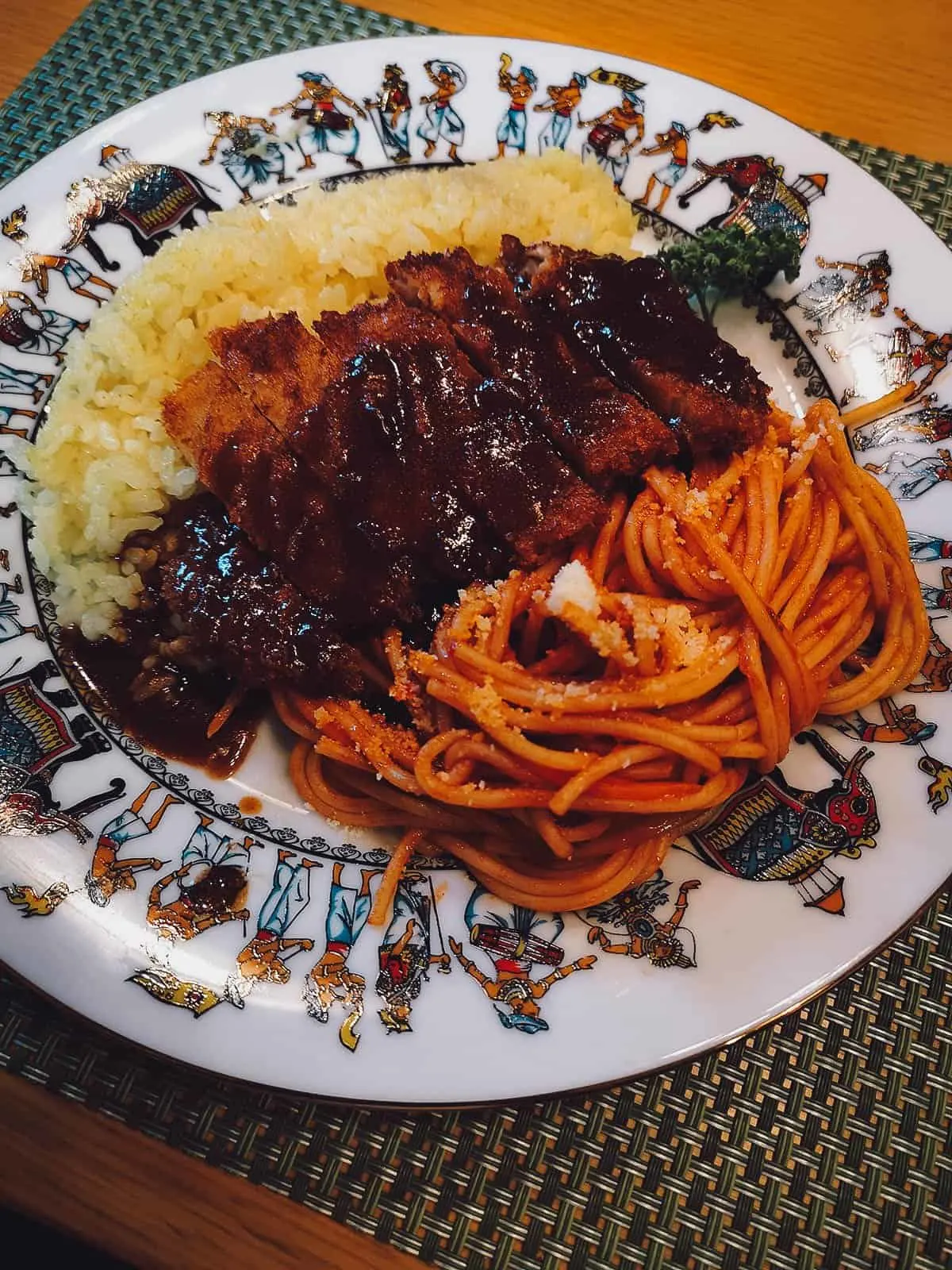
Dejima International Club Restaurant
Address: 大分県日田市豆田町4-14
Operating Hours: 10:30AM-3PM, daily
What to Order: Toruko rice
9. Chinese Food
I know what you’re thinking. Why were we taken to a Chinese restaurant while on a FAM trip to Japan? This may seem strange anywhere else but not in Nagasaki. As described, Nagasaki’s cuisine was heavily influenced by the Chinese as evidenced in dishes like champon and kakuni manju.
Because Nagasaki was the only port open to foreign trade, it was the only Japanese city Chinese traders could visit at the time. Some settled here and established the country’s oldest Chinatown, which is just one of three in Japan. The other two are in Yokohama and Kobe.
Nagasaki Shinchi Chinatown is one of the best places in the city to have core Japanese-Chinese dishes like champon and sara udon.
Chukaen
They took us to Chukaen, a Chinese restaurant in Nagasaki Shinchi Chinatown that’s been around since 1946. I don’t know much about regional Chinese cuisine so I don’t know what type of Chinese food is common in Nagasaki, but most of the dishes served tonight were familiar to me, like this platter of cold cuts.
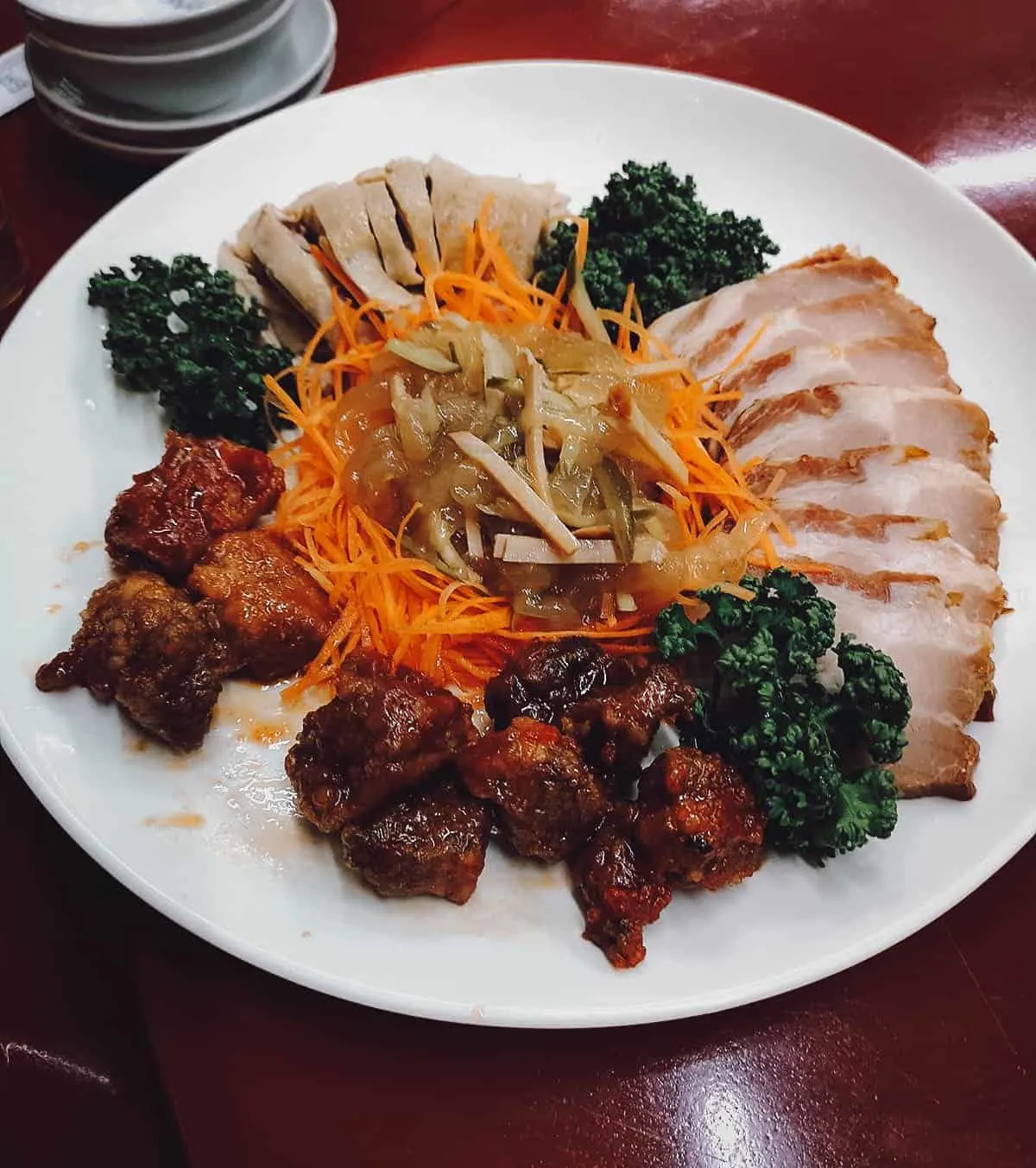
I believe this was hot and sour soup. I don’t know if these dishes are purely Chinese or Chinese with Japanese influences. They were familiar but perhaps a little different.
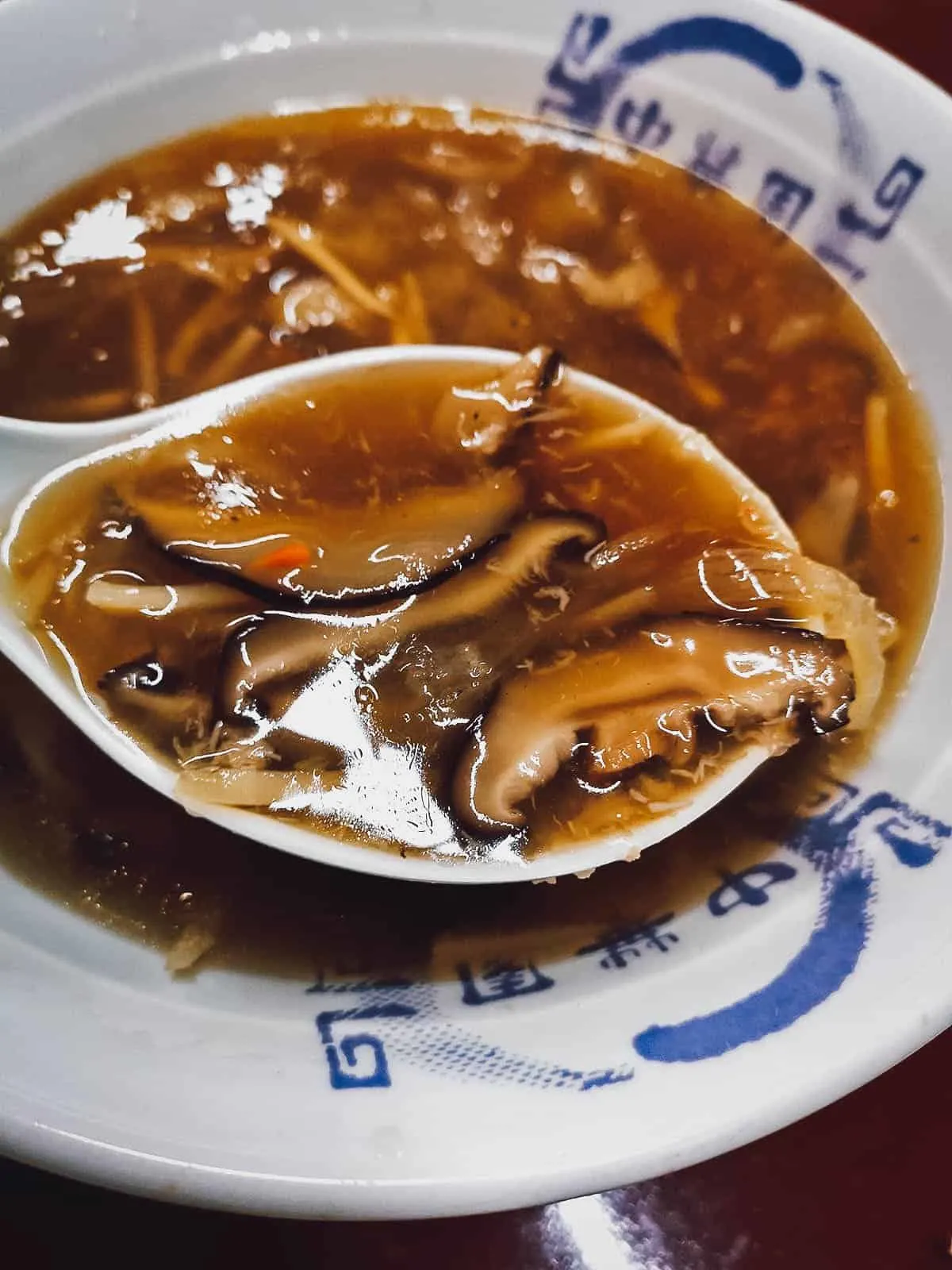
A platter of everyone’s favorite sweet and sour pork
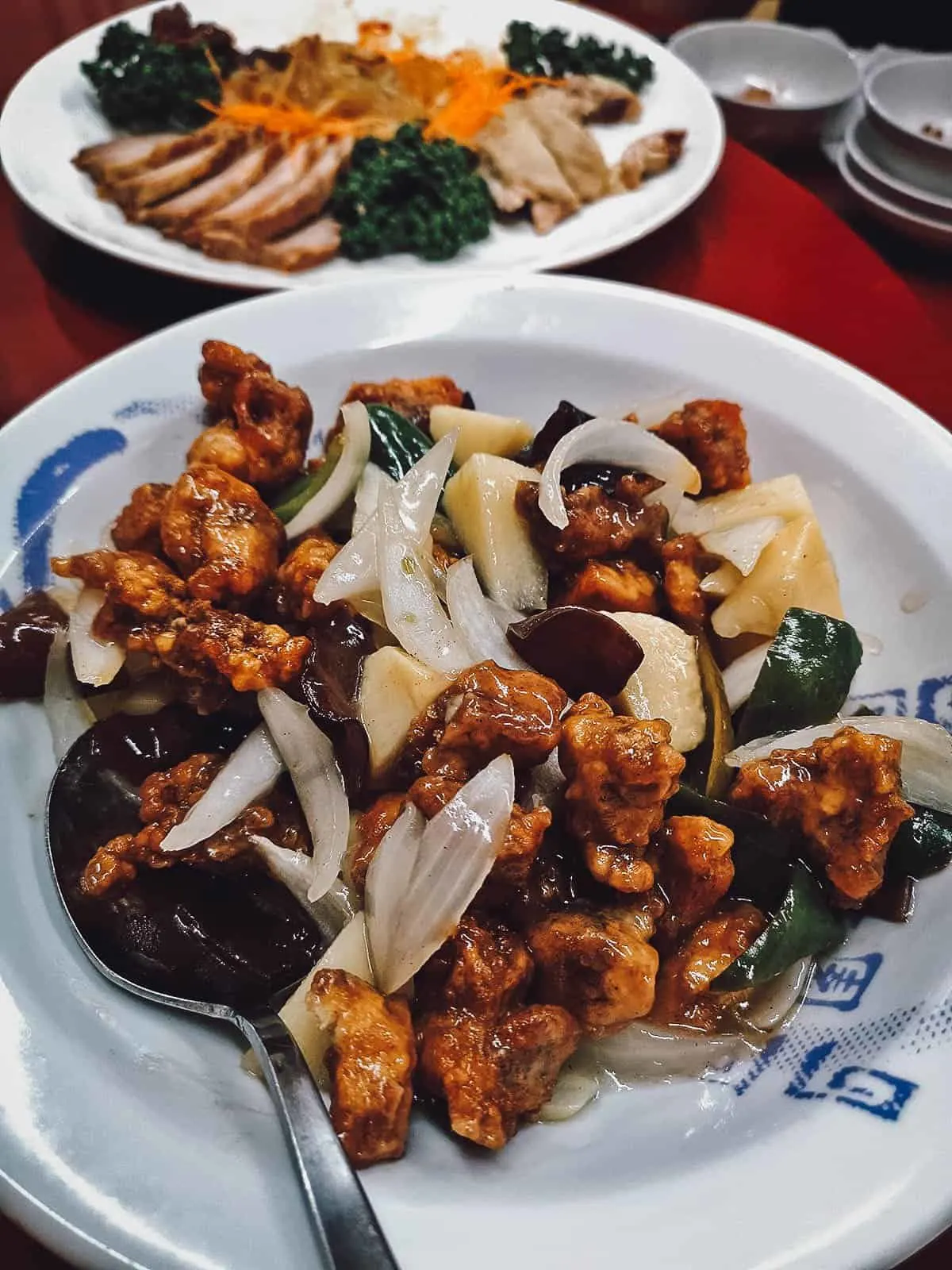
Shrimp toast and pork spring rolls
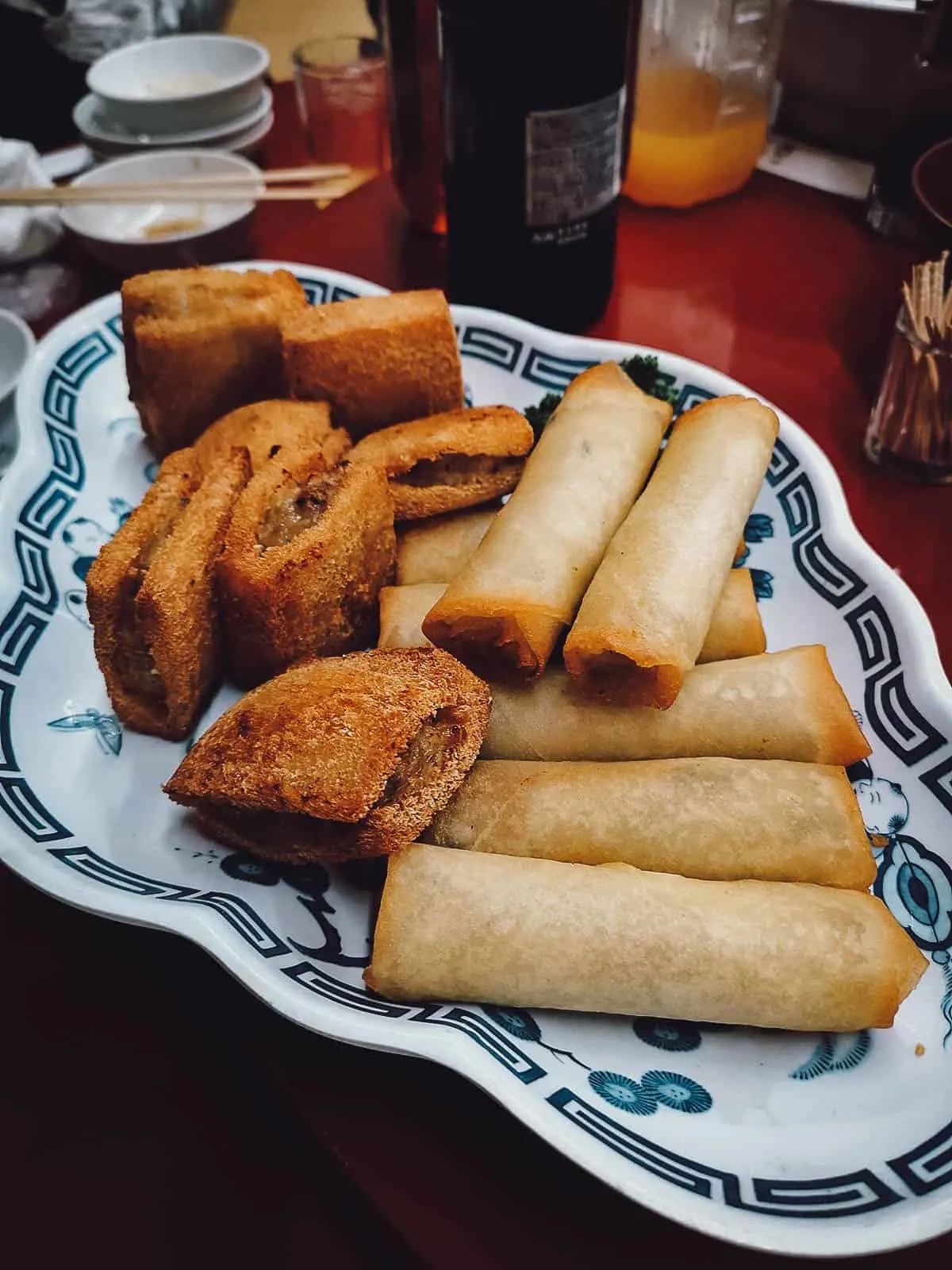
This shrimp dish in some type of sweet and sour sauce was my favorite from tonight’s spread. The sauce was a bit spicy and the pieces of shrimp were succulent and tender.
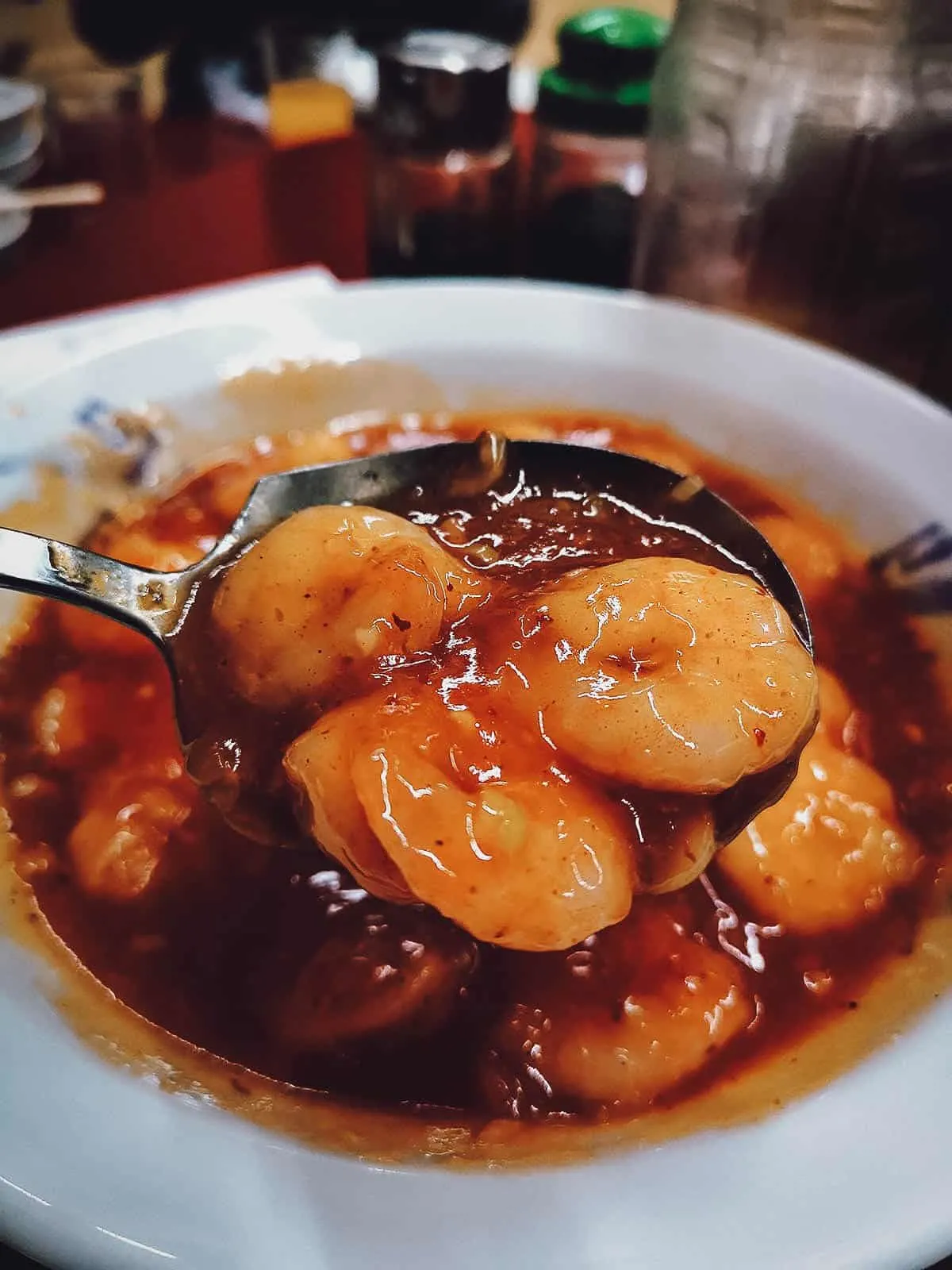
This chow-mein-looking dish is called sara udon. It’s made with a base of two types of noodles – one soft and thick and the other thin and crispy – and topped with a host of ingredients like cabbage, bean sprouts, squid, pork, and kamaboko (surimi). Like champon, it’s a core Japanese-Chinese dish associated with Nagasaki.
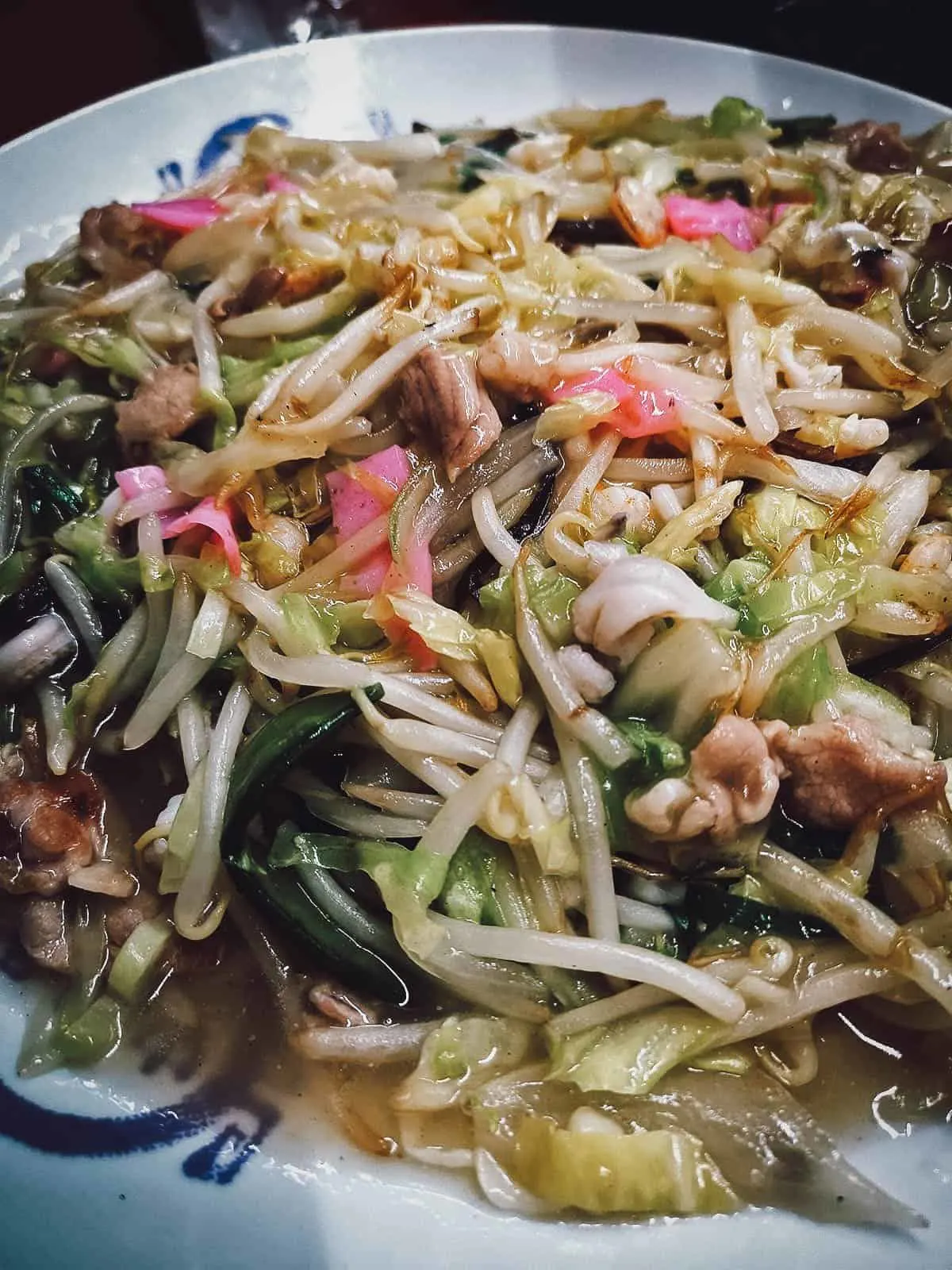
Chukaen
Address: 8-4 Shinchimachi, Nagasaki 850-0842, Nagasaki Prefecture
Operating Hours: 11AM-2PM, 5-10PM, Wed-Mon (closed Tues)
What to Order: Champon set meal
10. Chirin-Chirin Ice Cream
The last dish on this list is this pretty ice cream treat we enjoyed at Nagasaki Peace Park. Scooped and molded to resemble a flower, chirin-chirin ice cream has been a popular streetside snack in Nagasaki for over fifty years. It’s named after the sound made by the brass bell from vendors’ ice cream carts. Chirin chirin!
We enjoyed a cone each at Nagasaki Peace Park but you can find chirin-chirin carts in many locations throughout the city.
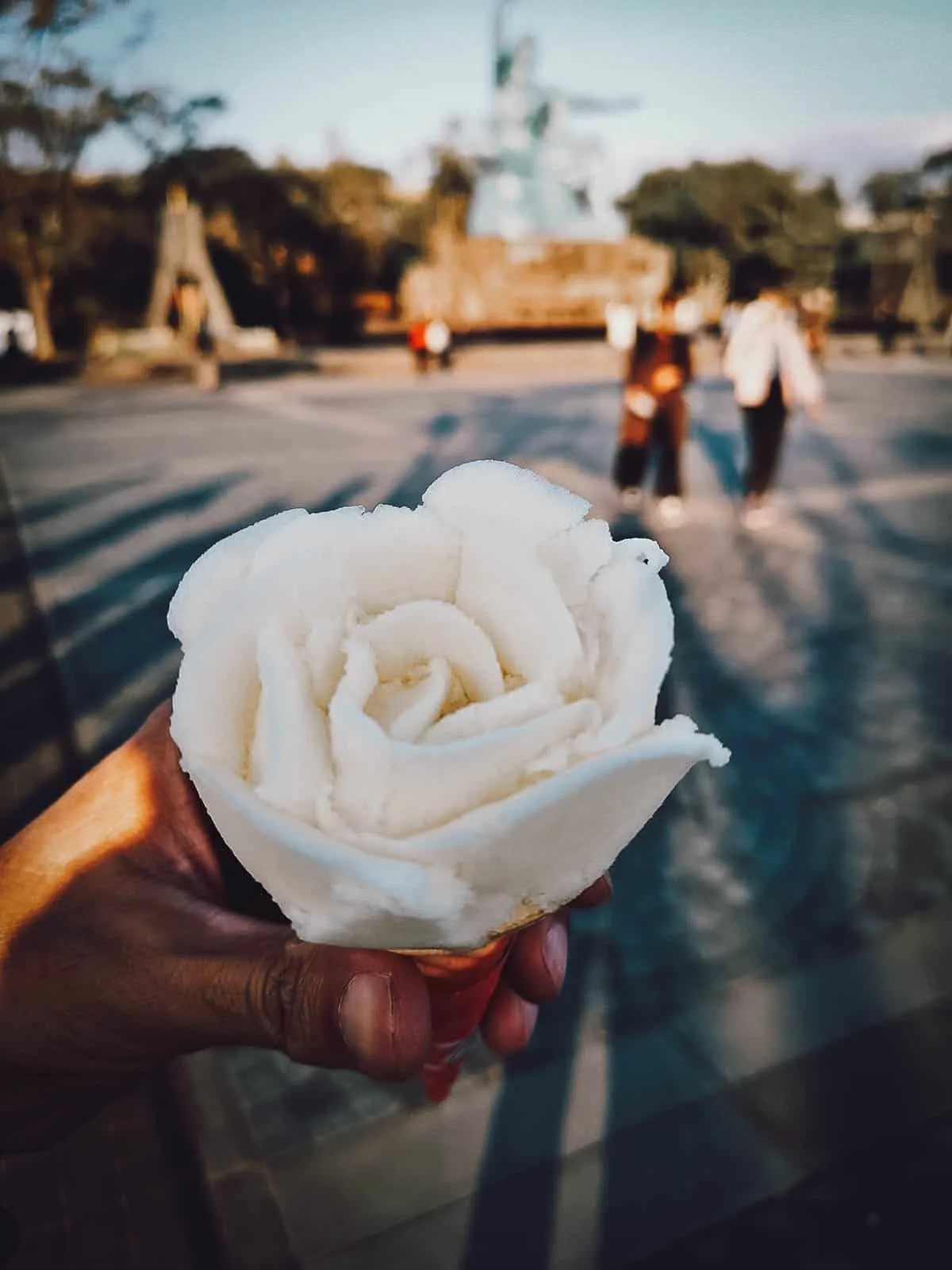
FINAL THOUGHTS
As much as we love Japanese food, it isn’t all we love about Japan. No matter how many times you’ve been, this country never fails to charm and disarm you. WeI often tell each other that if we were to visit just one country for the rest of our lives, then it would definitely be Japan. It is captivating in so many ways.
Most first-time travelers flock to either Tokyo or Osaka, and that’s understandable. Those are two of the most popular and exciting cities to visit in Japan. But if you’re looking for something different, something a little less explored, then the island of Kyushu is a great place to visit. As described, we first visited northern Kyushu on our own two years ago and I’ll be going back again in February of next year. After that, we plan on exploring Okinawa and the rest of southern Kyushu.
From its hyper technology to its fascinating customs to the people’s mindfulness and their mind-blowing food, there is so much to love about Japan. I don’t think we’ll ever grow tired of it.
To my fellow Filipinos, if this article has whetted your appetite in any way, then you’ll be pleased to know that Cebu Pacific can fly you direct from Manila to Fukuoka. I suggest following them on Facebook to stay abreast of the latest seat sales.
A massive thank you to Cebu Pacific and as always, happy traveleating!
Disclosure
Cebu Pacific Airlines sent me on an all-expense paid FAM trip to northern Kyushu with other content creators from the Philippines. With Tokyo and Osaka being the more established destinations, the goal of this trip was to bring more attention to the island of Kysuhu. As always, all thoughts, words, and opinions expressed in this article are mine and mine alone.
The TripAdvisor links in this post are affiliate links, meaning we’ll earn a small commission if you make a booking or reservation at no extra cost to you. We really appreciate your support as it helps us keep this website going. Thank you!


Aloha Hawaii
Wednesday 5th of August 2020
I never leave Japan without having unagi at least once during my trips to Japan. Can't get enough of it. It all started when my Osaka uncle took us to an unagi restaurant, that started my unagi addiction.
JB & Renée
Thursday 6th of August 2020
@Aloha Hawaii: I completely understand! I still remember my first taste of unagi too. It was at a sushi restaurant in Boston over 30 years ago. I fell in love from that very first piece. Unagi is magic.
Cindy
Tuesday 10th of December 2019
May I know the tour company u use for this trip, pls
JB & Renée
Tuesday 10th of December 2019
Hi Cindy, our guide Miki-san works for THIS COMPANY.